Harvesting your own black walnuts is a labor of love gaining popularity with more and more foragers. This post will show you everything I've learned: harvesting, cleaning, storing, cracking, cooking, and everything in between.
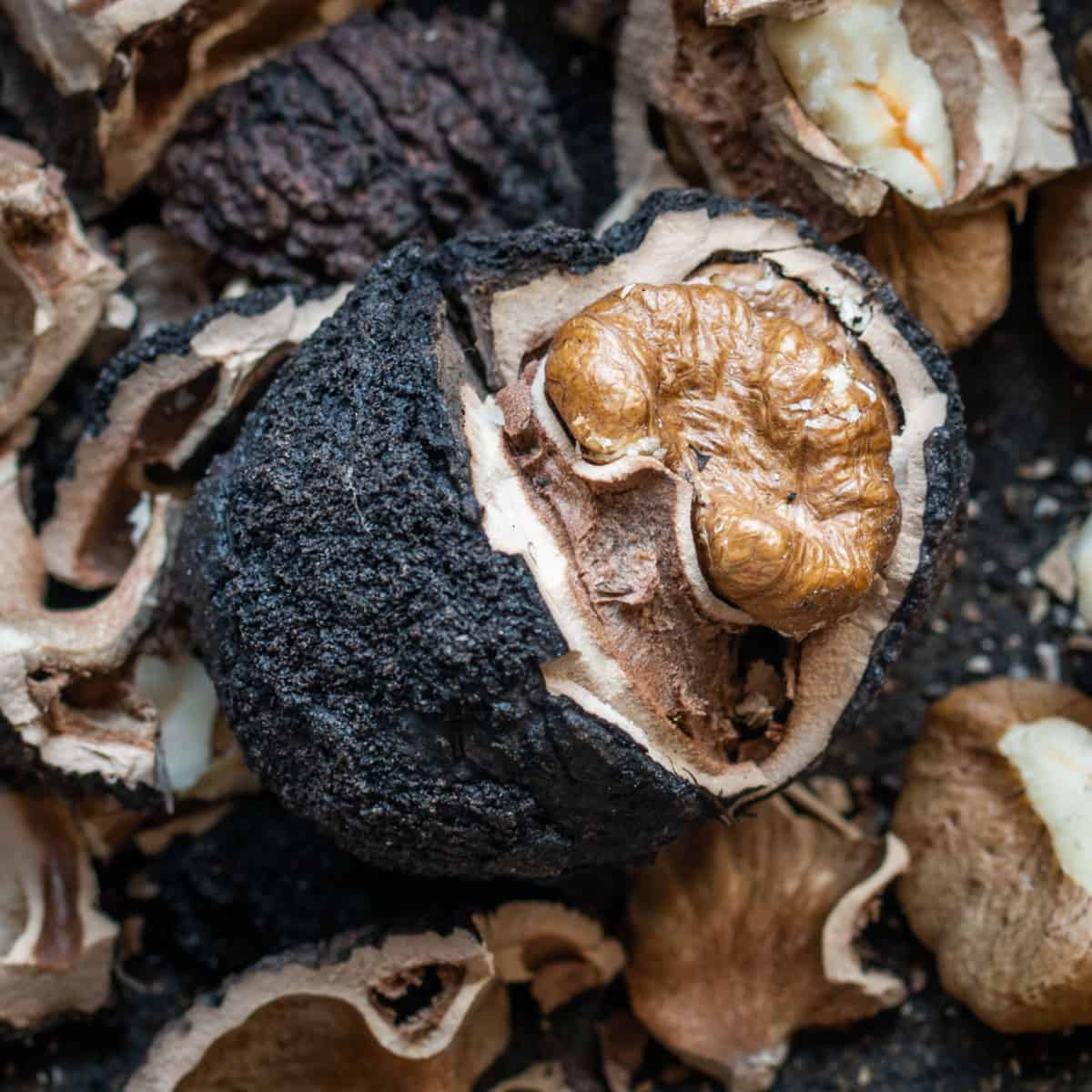
Like a lot of other people, I have memories of tripping and stepping on ugly, gooey black walnuts in the yard when I was growing up. They were a serious pain when I had to mow the lawn, and I thought they were weird, not food--no way they could actually be related to regular nuts that we eat, right?
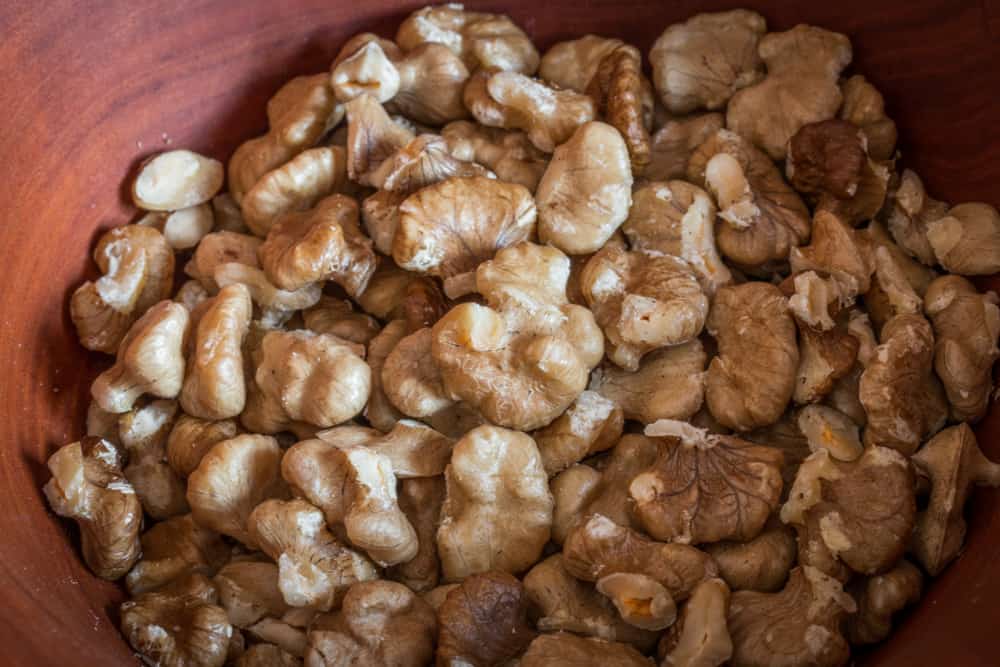
As I worked my way through the culinary industry, black walnuts took on a new identity as a treasured, expensive product that was near impossible to source. When I was opening up my first restaurant, I looked at buying them from an exclusive purveyor and did a double take when I saw the price tag: over 40$ a lb.
Black Walnut vs English Walnut
Both walnuts are related and are in the Juglandaceae family. Black walnut trees are Juglans nigra and are common wild walnuts. and English walnut trees are Juglans regia-the same walnuts sold in grocery stores.

The trees are slightly similar and both have opposite, pinnate leaves but the nuts are very different. The pictures below illustrate some differences between both trees.
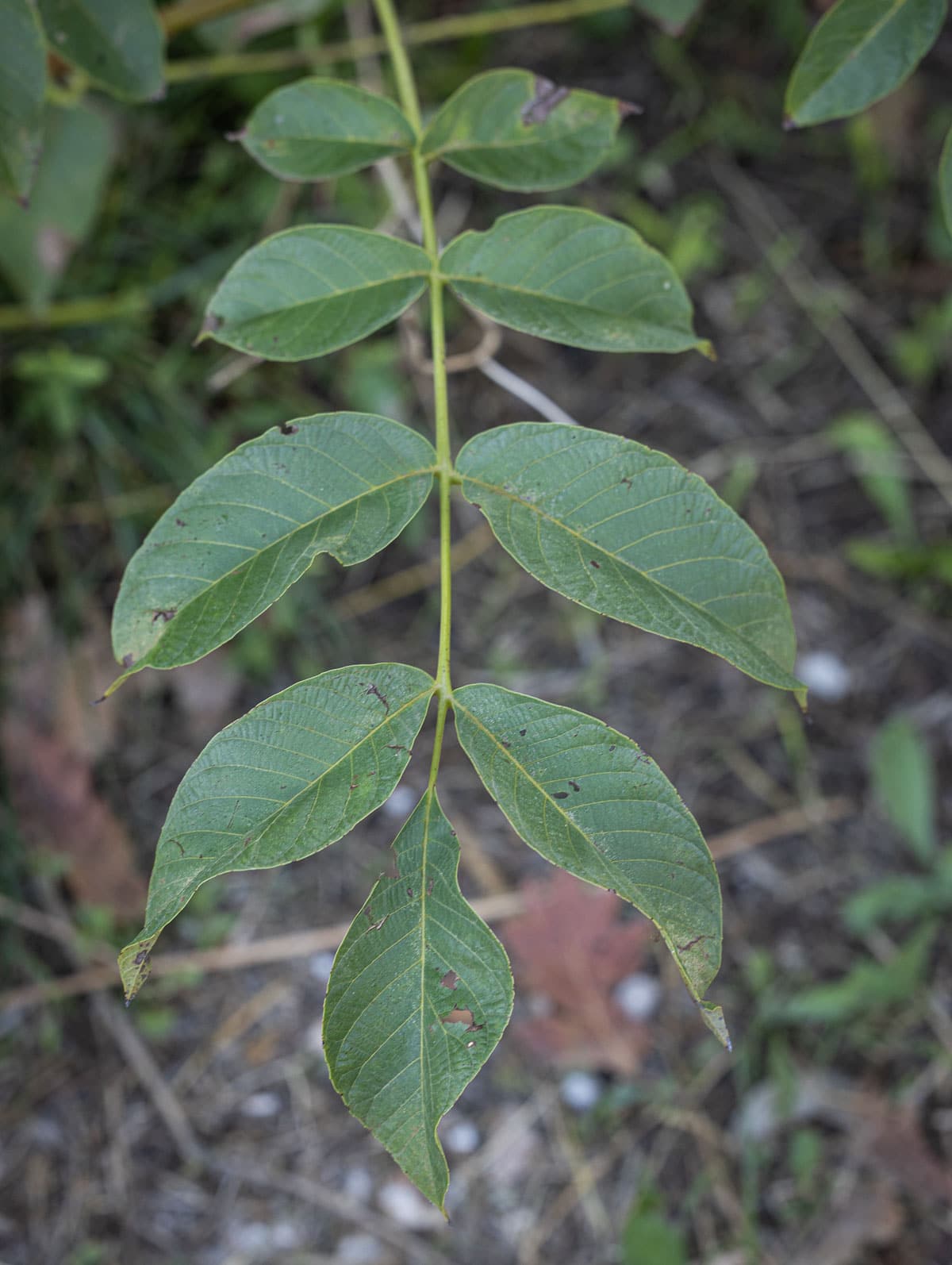
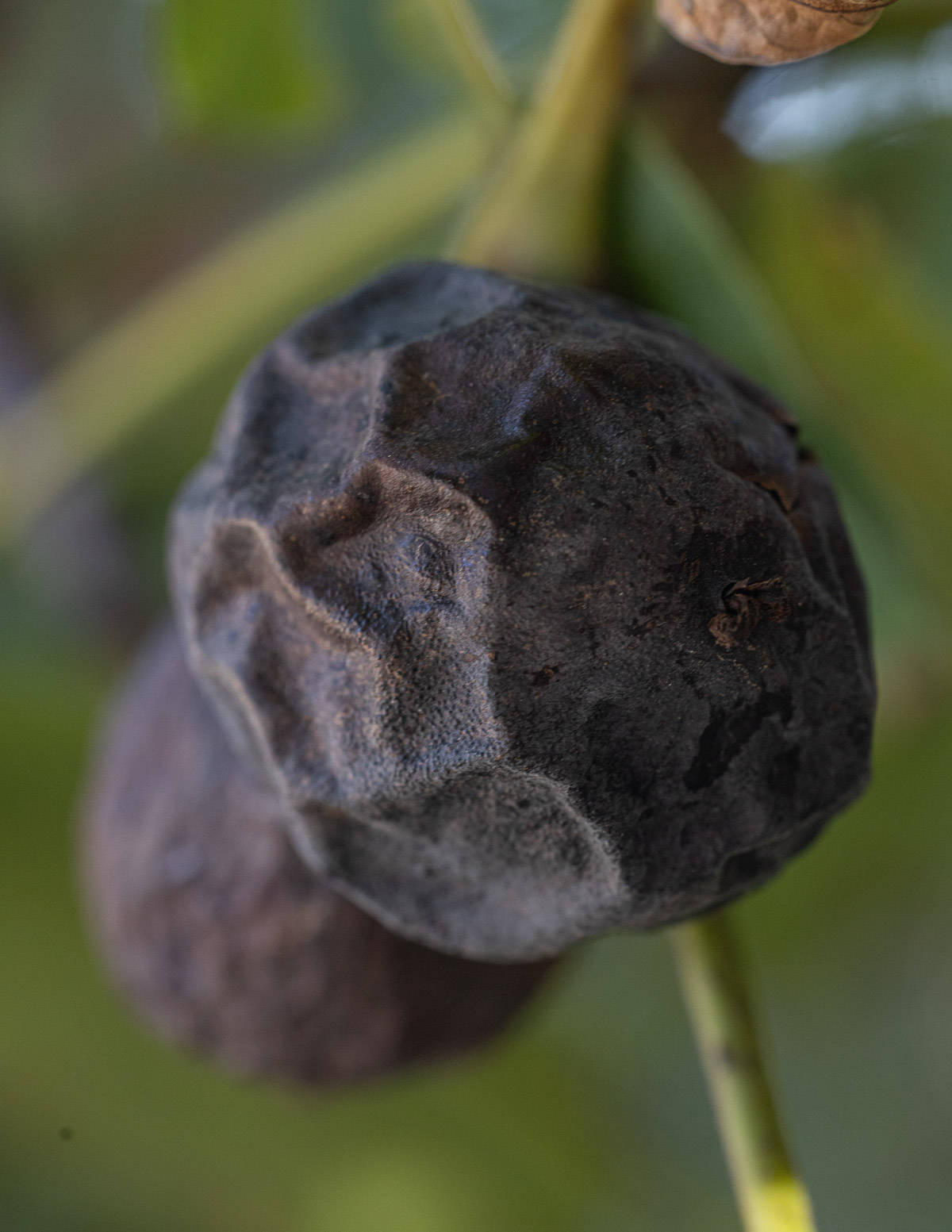
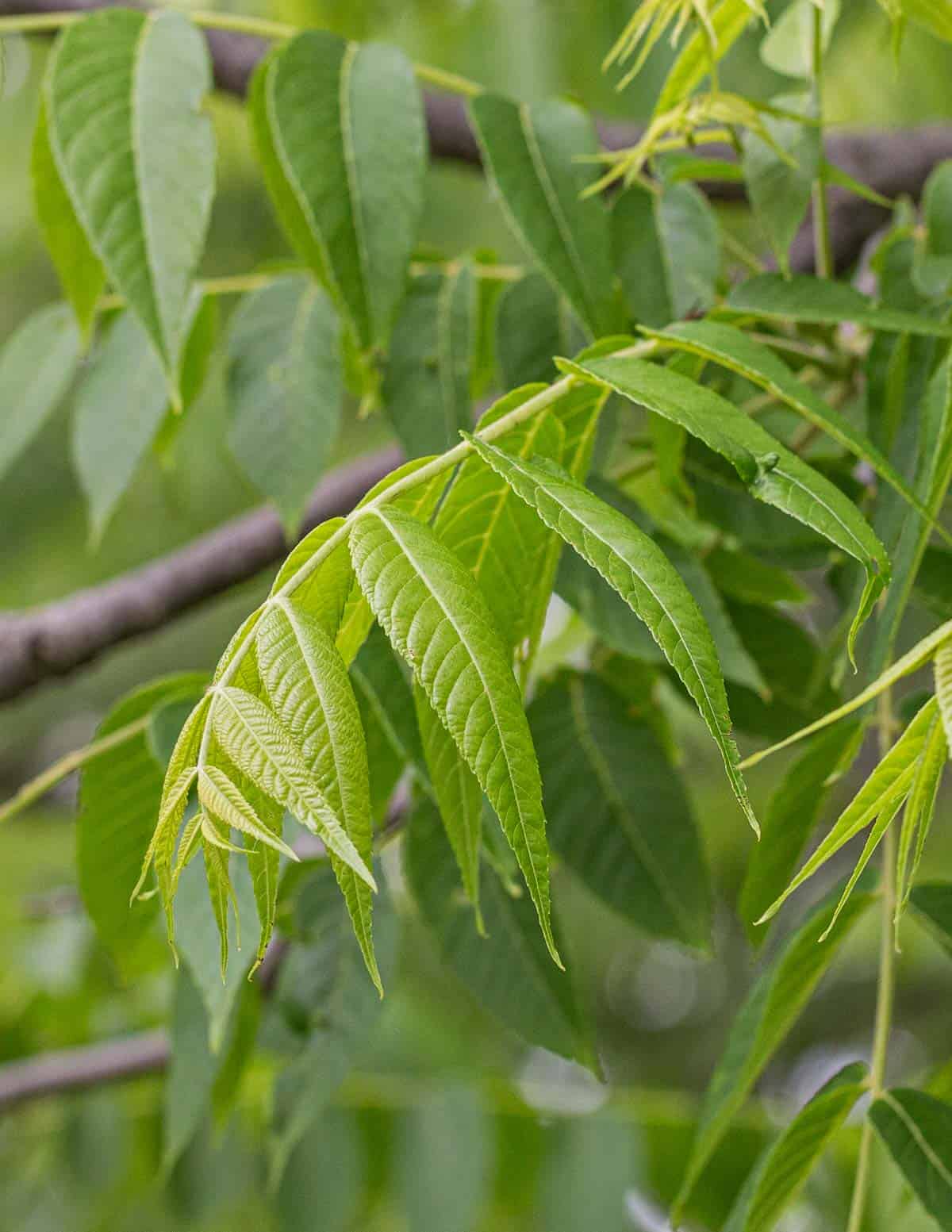
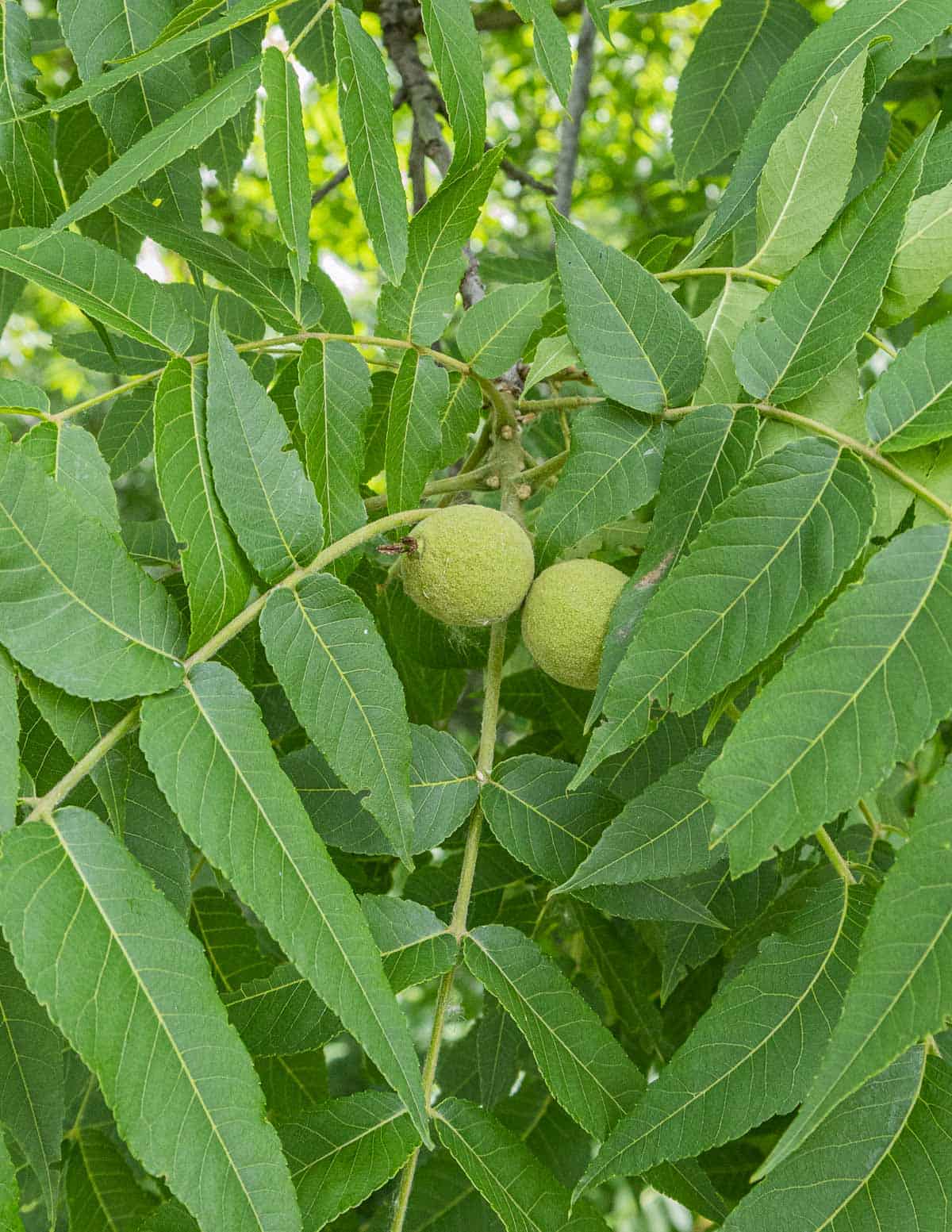
English walnuts have very thin shells compared to black walnuts, and the flavor is very mild, where black walnuts have incredibly hard shells and a very strong, earthy flavor. If you like the flavor of both nuts they can be interchangeable in cooking.
Where to Buy Black Walnuts
Hammons is now the premier supplier of black walnuts in the United States, who sell them at industrial scale at an affordable price. When I need large amounts I order from them. They're also the only supplier that sells black walnut oil.
Hammons nuts, while available in bulk, are mechanically separated, and they take a beating during the process in flavor and shape. Simply put: cracking black walnuts by hand is how you get the most intense flavored, perfect-looking nuts possible.
Why would you harvest your own black walnuts with large scale purveyors in business, you ask? One word: quality.
You'll be able to smell the bowl of nuts as you crack them, and pressing them between your fingers will yield a fresh, aromatic oil. You'll be able to see black walnuts as a luxury, and brag to your friends about your command of a lost art.
Harvesting Black Walnuts
There's plenty of methods and opinions out there, but after a couple years of harvesting, here's what I've found to be the easiest for me. Once the trees start to drop their nuts around early October, I wait a bit for the hulls to soften before I gather them.
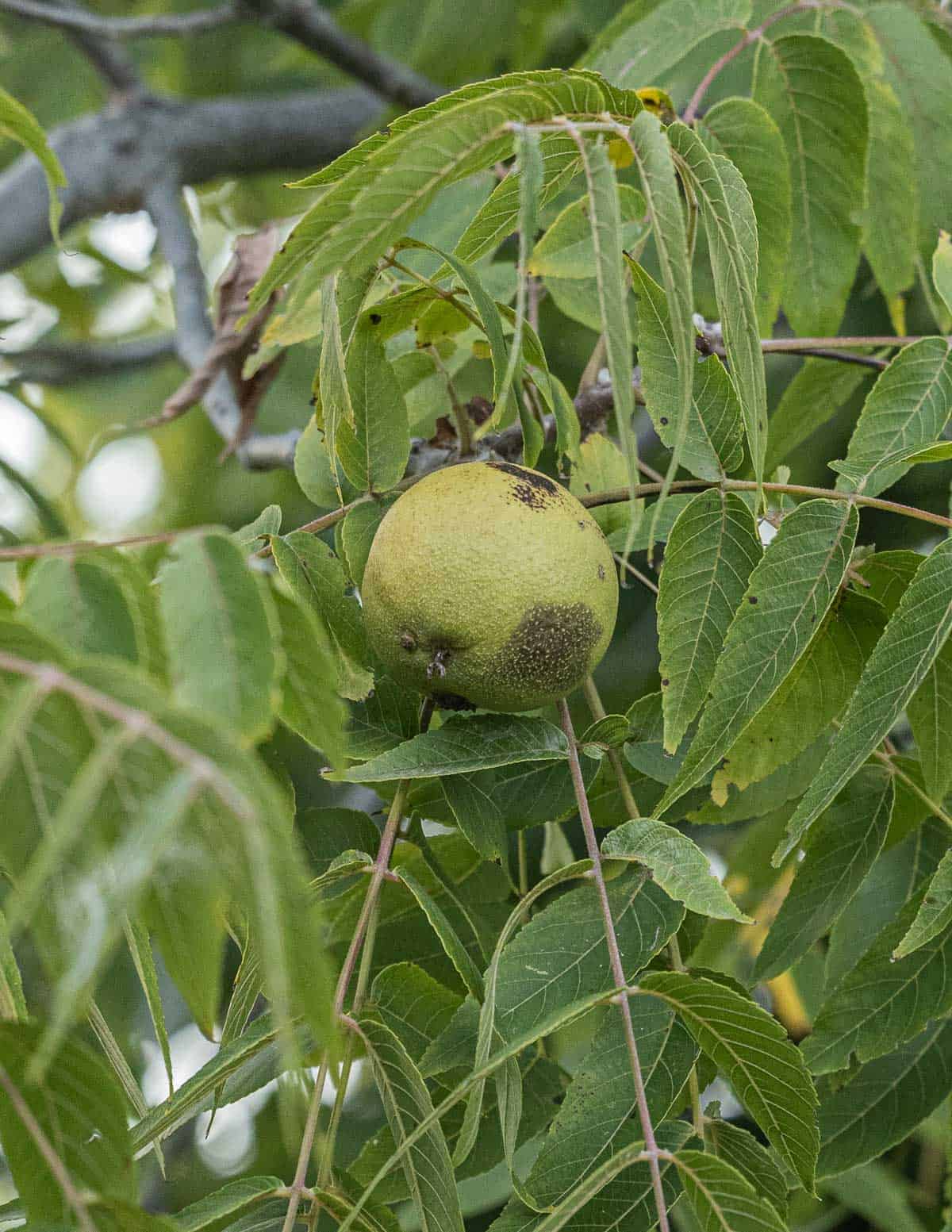
What happens here is that fly larvae will get into the thick green hulls, and begin feeding on them. After a bit, the hulls soften a little. From here, I go outside with a plastic tub, and, wearing gloves and using boots, I rub my heel over each nut, and the once hard green hull simply melts away.

Some nuts may need to be stomped a bit, and that's fine. What's happening here, is that I'm allowing the fly larvae (walnut maggots) to digest the hull, soften it, and in the process do a lot of the work of hulling them for me.
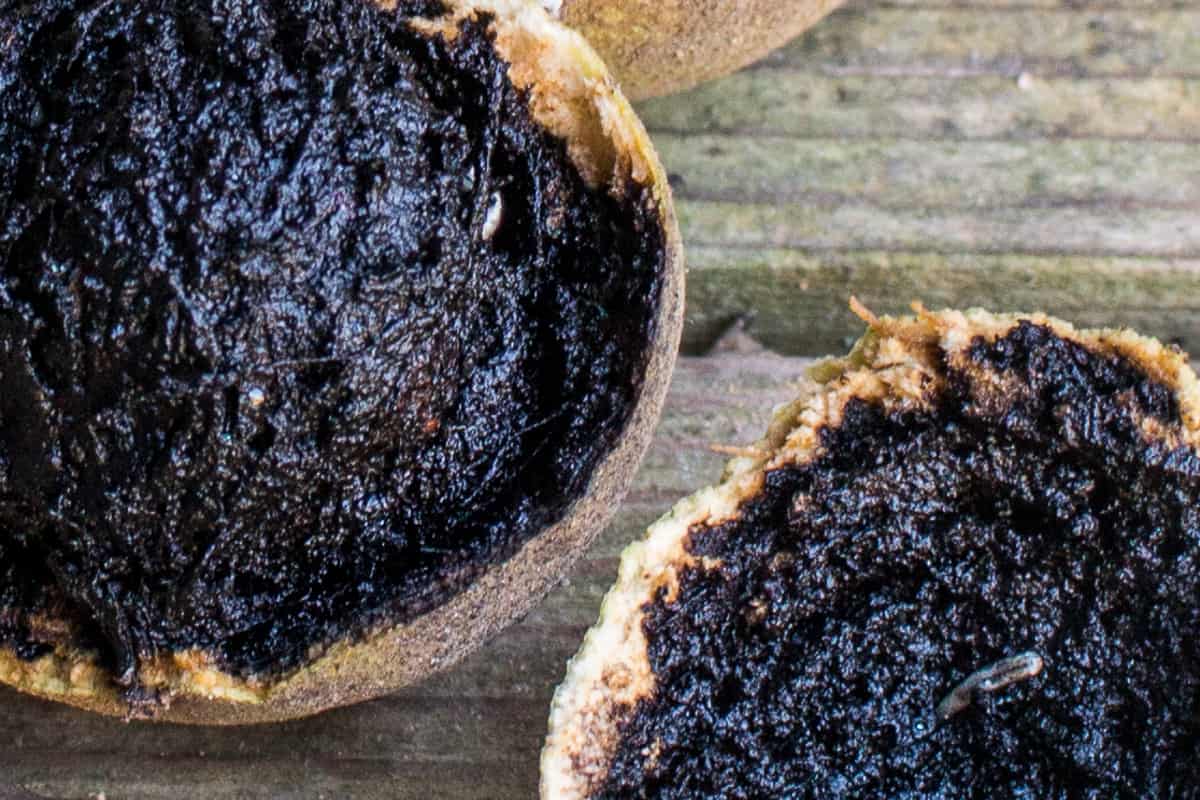
If you harvest the walnuts green, with the hulls firm, you'll need to find a way to remove the hull yourself, and you can find plenty of ideas for how to do that online. My advice, is make your peace with creepy crawlies, and let them help remove the green hulls for you.
Nuts can also vary drastically in size from tree to tree, so you'll also want to look around and find trees you like the best.
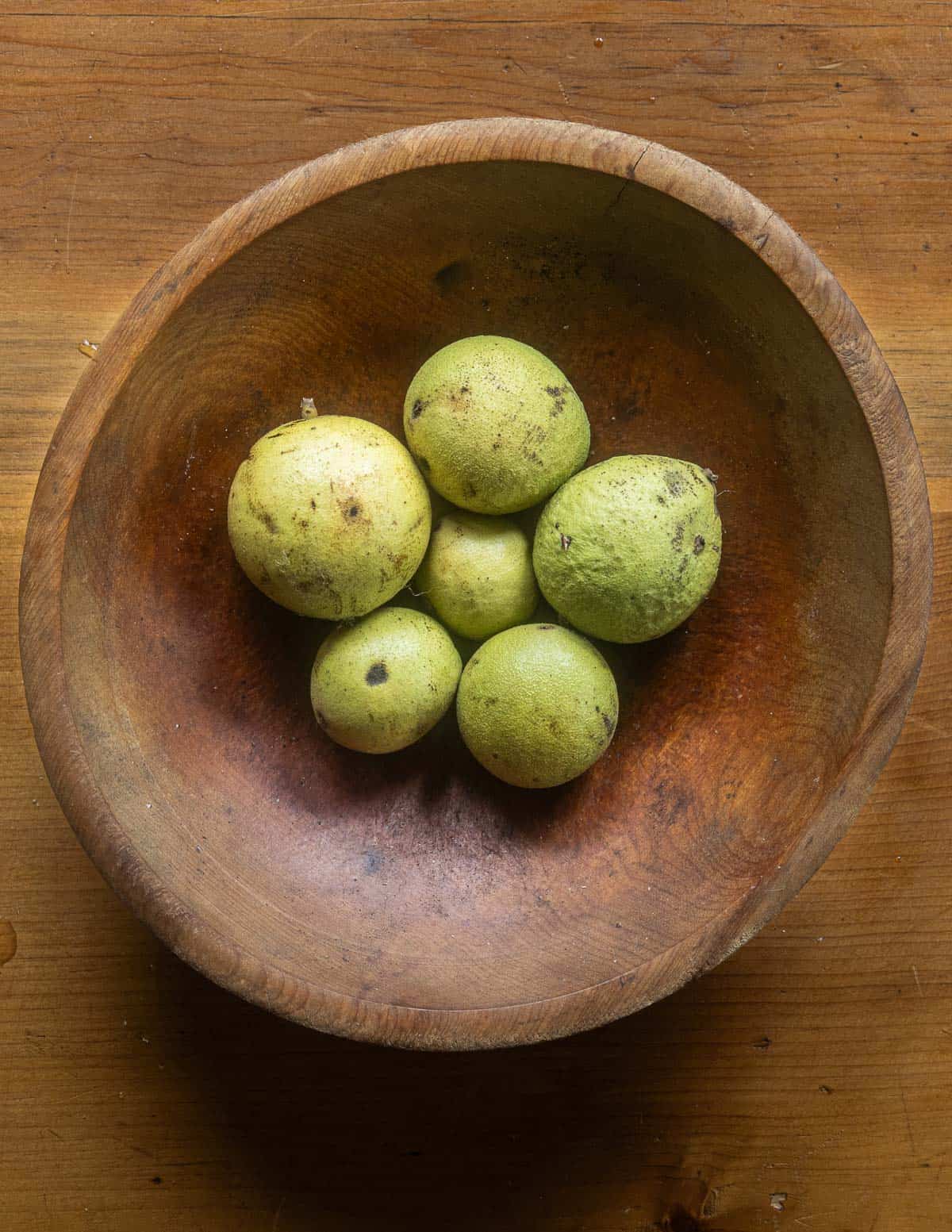
Processing Black Walnuts
After removing the hull the nuts will still be covered in black goop and need to be washed. Fill a big Rubbermaid or plastic container with them, get the hose, and fill the tub with water.
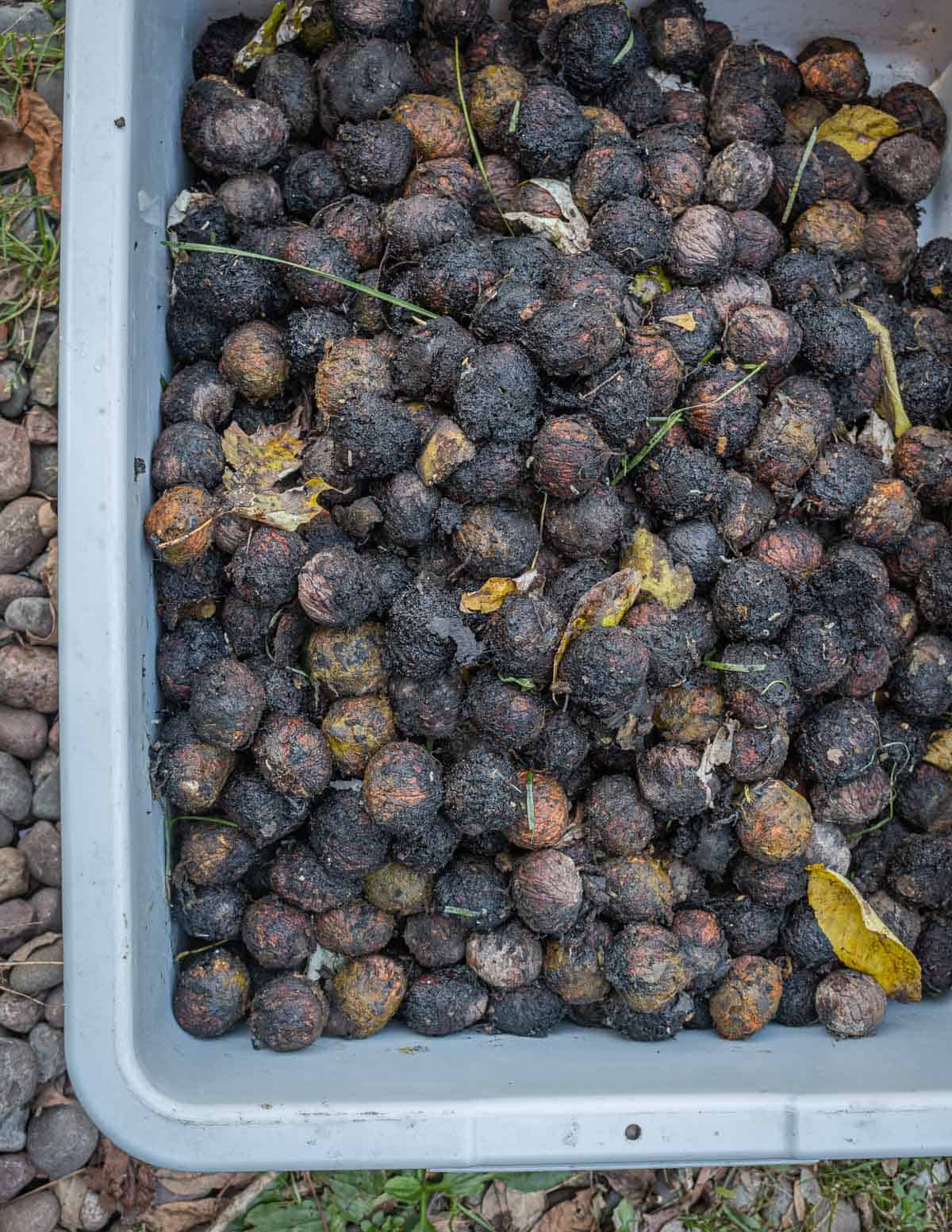

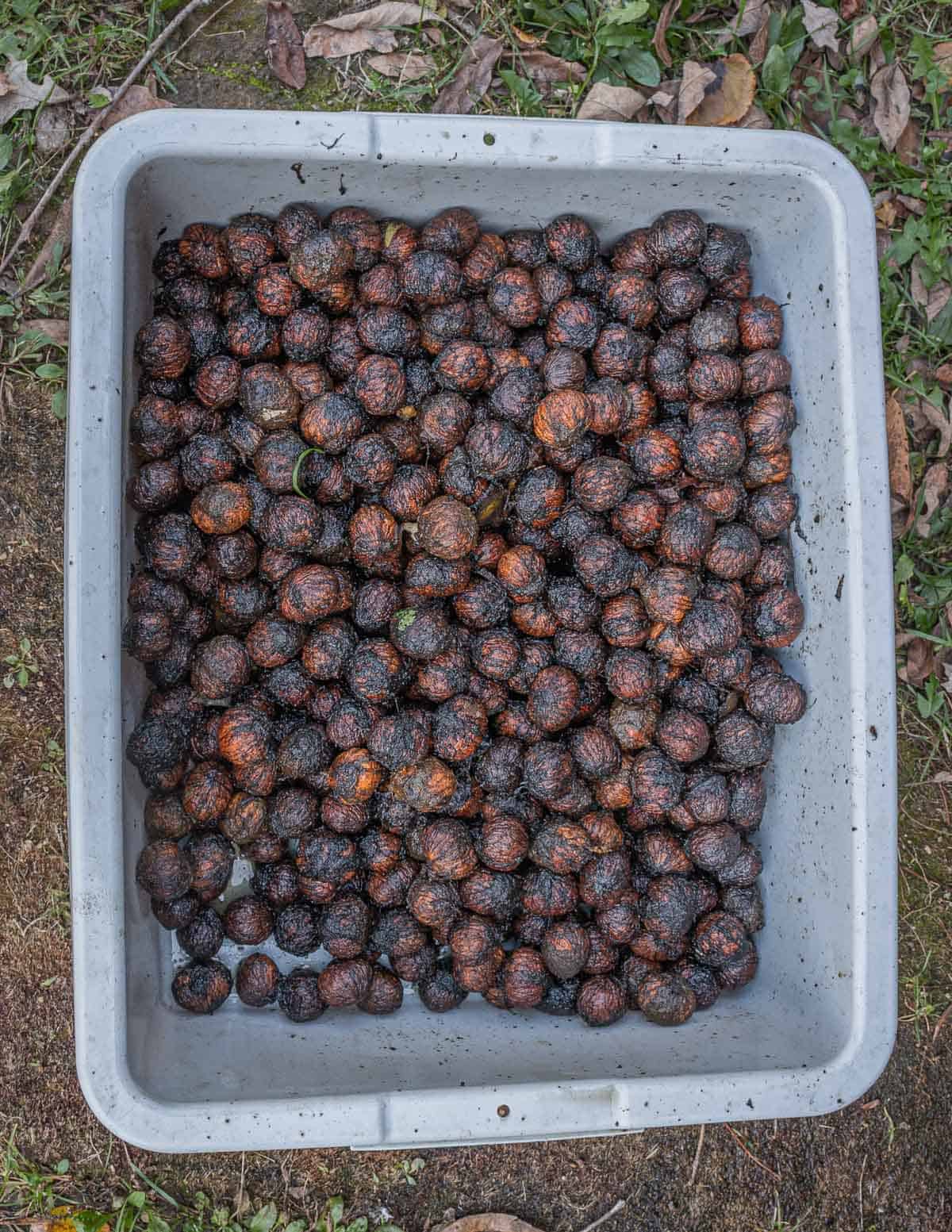
Using a stick or some other crude tool, swish the nuts around in the water to help loosen clinging bits of hull. Dump the water, then repeat the process a few times until the water runs clear.
Discard any nuts that float, and do not leave the nuts in water for longer than it takes to wash them, or they can mold during the curing process.
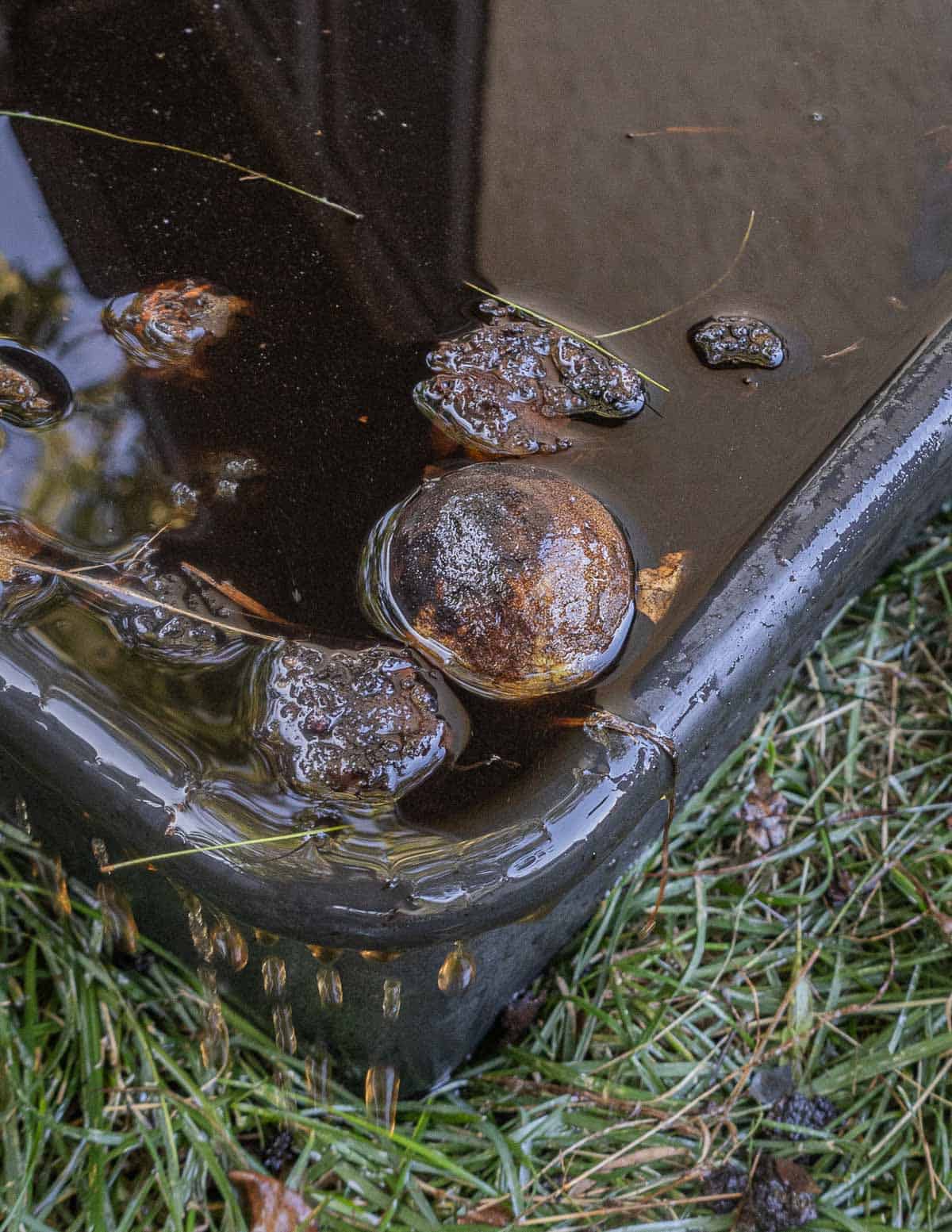
Drying / Curing
Once the nuts are drained they need to be cured/dried. Put the nuts in a wide container to dry in a cool place with ventilation--a porch or garage is fine but make sure squirrels can't get into them.
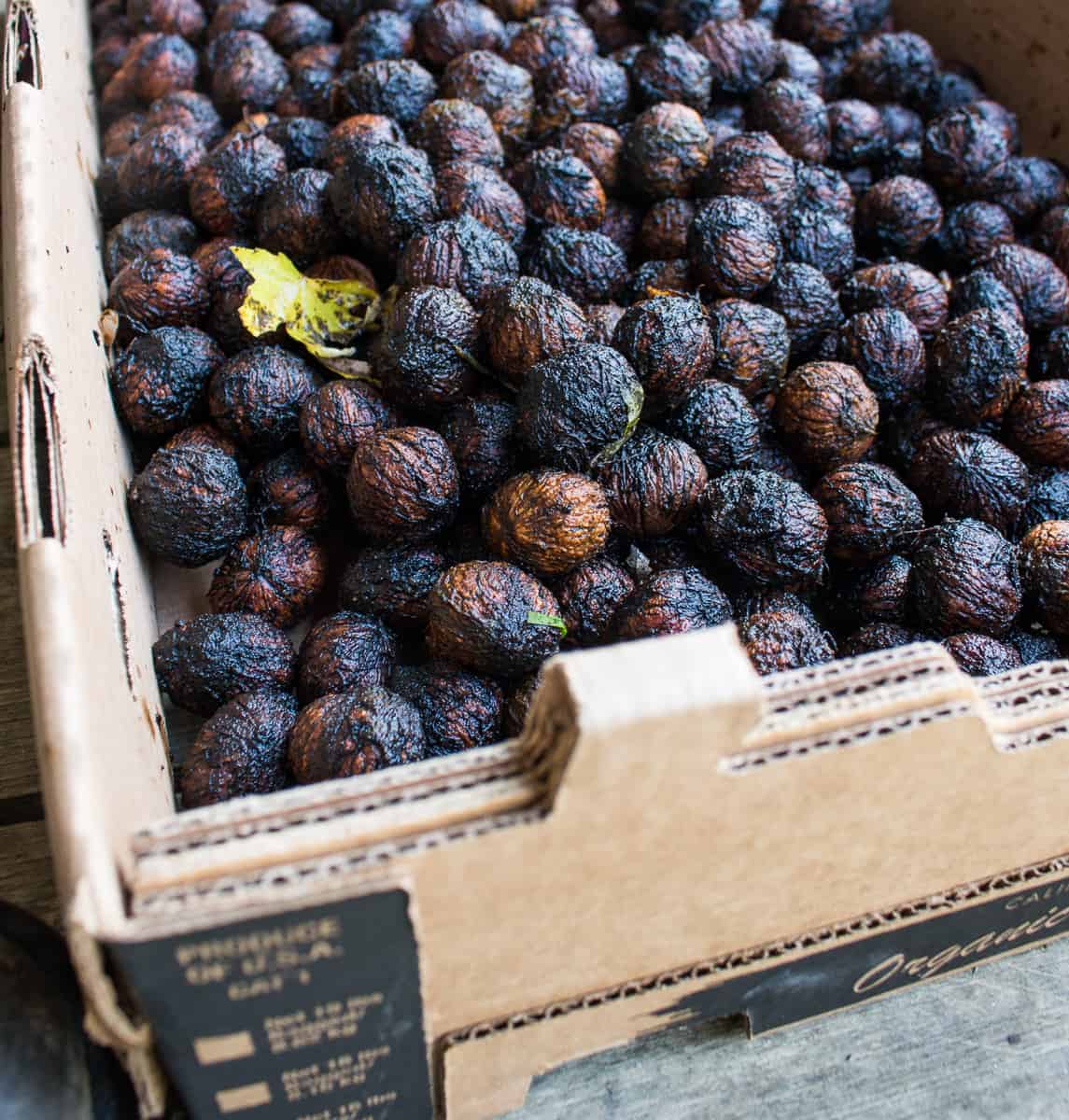
A net bag works, as will laying the nuts out on screens, or in a cardboard box as long as you have a fan or something to move air over them, as even a small amount of water in the bottom of a container can cause the nuts to mold.
The most important thing is that your nuts are bone dry. There's a few ways to dry the nuts I'll go over below.
Box Fan Method
I like to use sheet trays and a fan in my garage, as illustrated below. It typically takes 2-3 weeks for my nuts to dry completely.
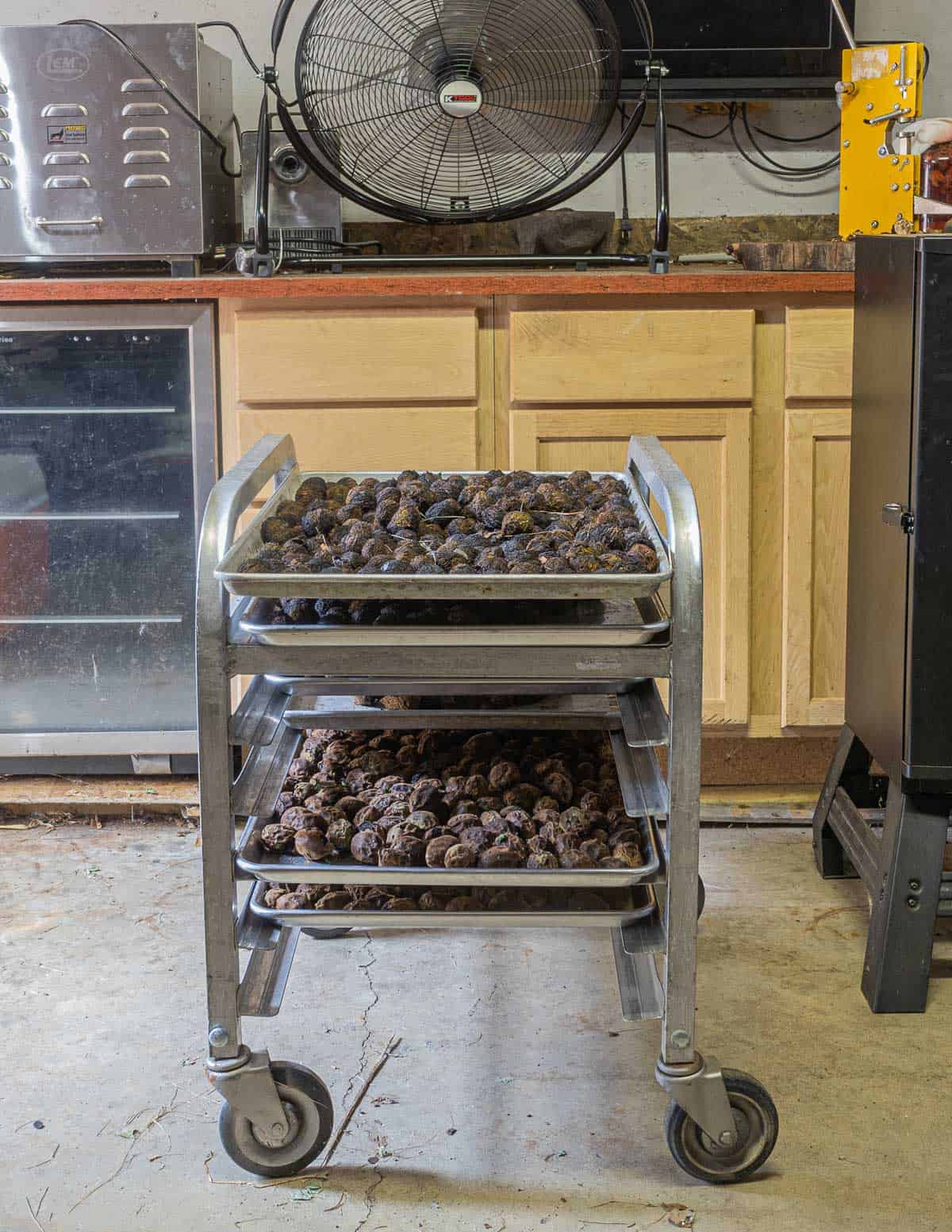
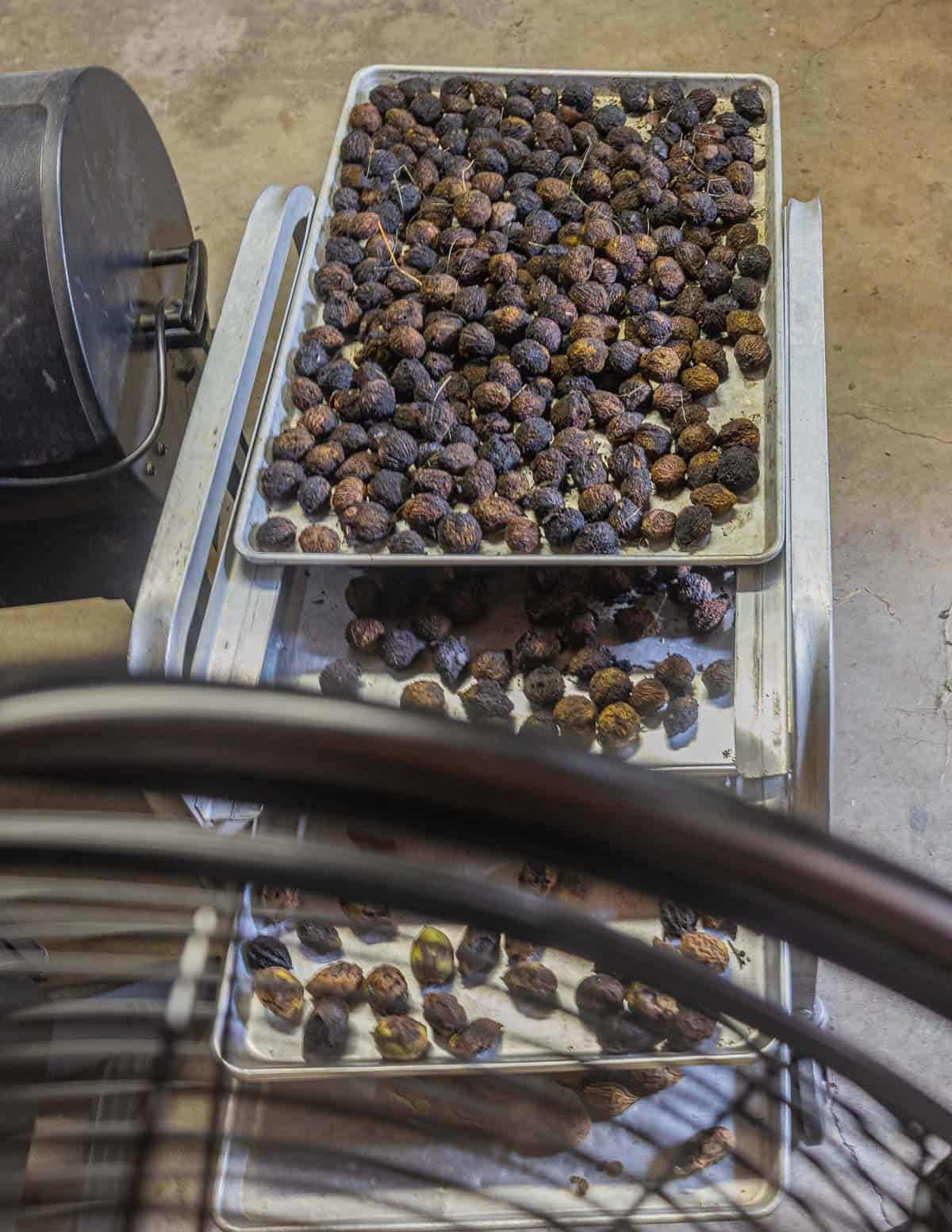
Dehydrator
You can also dry black walnuts in batches in a dehydrator, (use a large square model like Harvest Maid or Excaliber) and it is the fastest way to dry them.
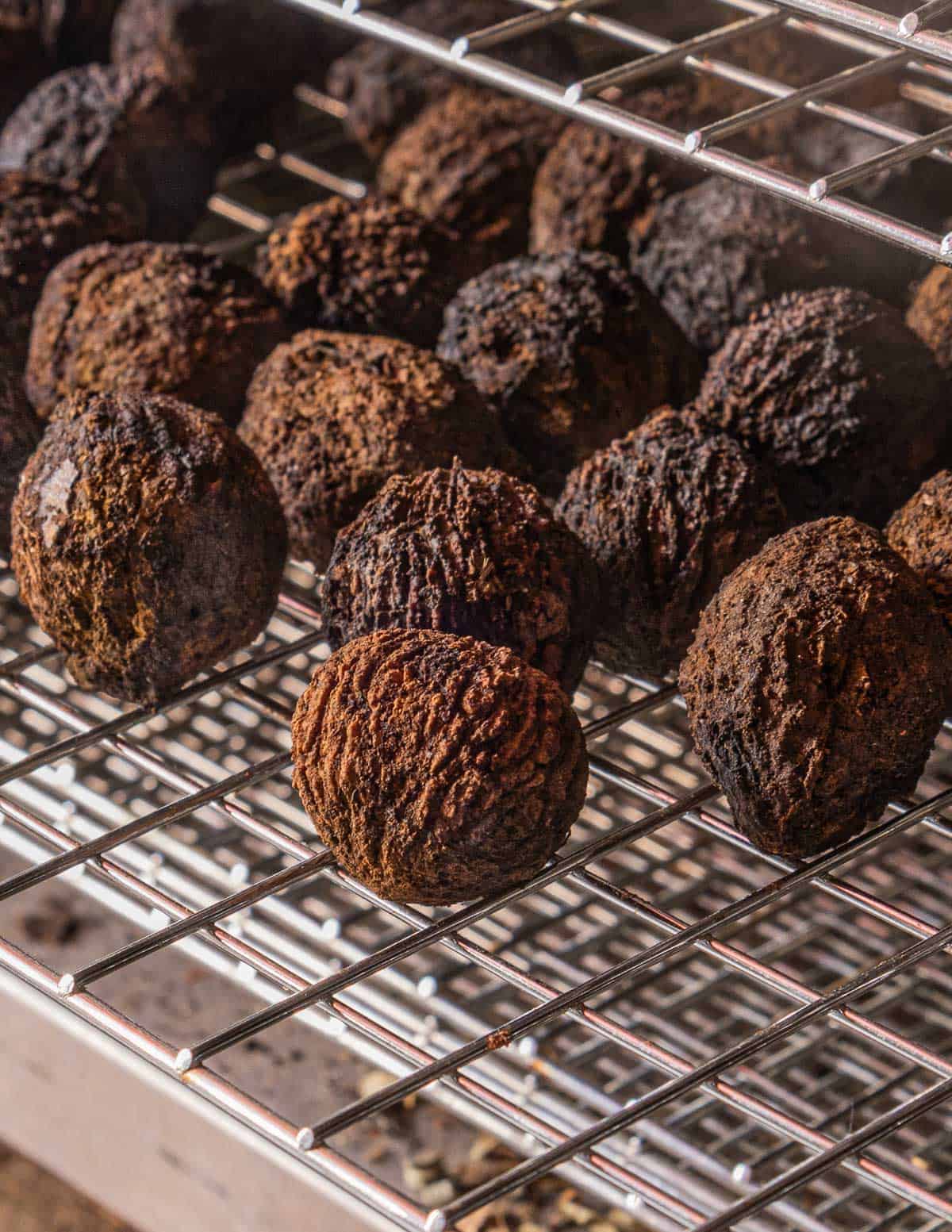
Putting them on cookie sheets in an oven with an adjustable temp around 150 could work too, but I would crack the door to avoid cooking them. Use this as a last resort.
Allow the cleaned nuts to dry and cure for roughly 3 weeks or until they're completely dry. From here, the nuts are shelf stable, and can last for a few years, allowing you to crack and enjoy them as you like.
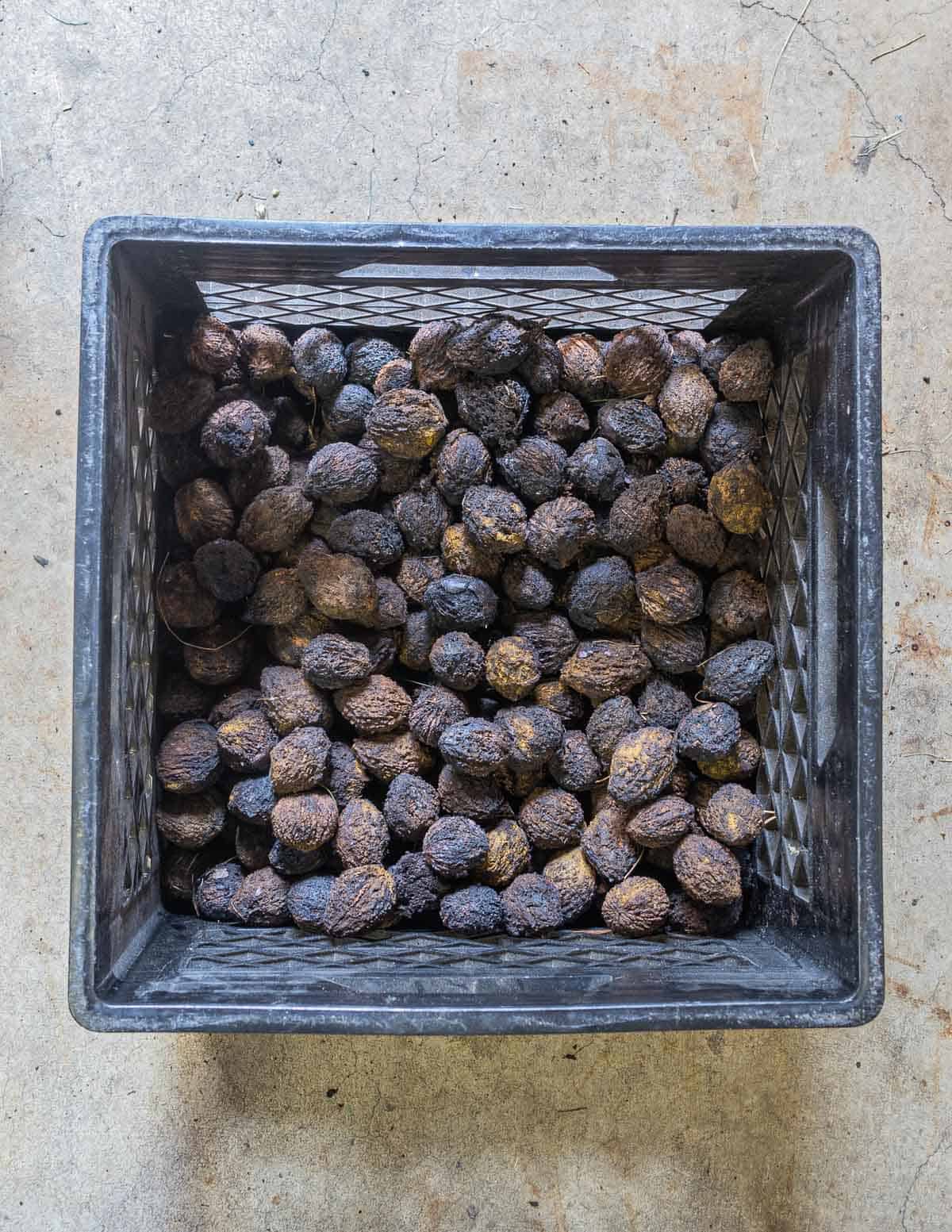
Outsmarting the squirrels
It can be tempting to store the nuts outside after washing, especially if you don't have room to put the nuts on screens, but squirrels are talented nut thieves, and, if you leave the nuts out unattended for even a few days they will find your stash and help themselves.
I learned the hard way when I picked and processed all the black walnuts I could find one year, left them in a box outside, only to find that over the course of a week, the single squirrel that runs around our yard had helped himself to over 2 gallons of nuts.
Cracking
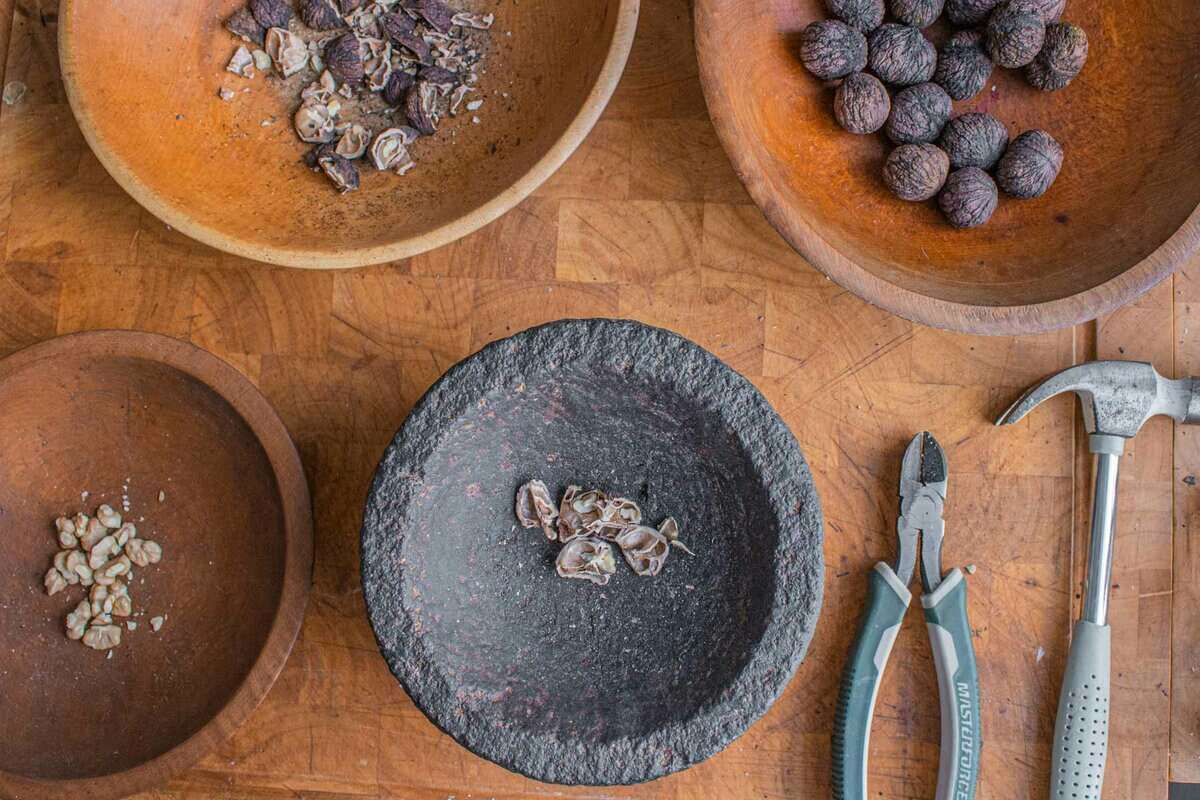
The most difficult part, and why I swore I would never crack my own black walnuts. One taste of a freshly cracked black walnut though and you'll be a believer.
Black walnut shells are amazingly hard--much harder than English walnuts, and you won't be cracking these in a rocking chair with Grandpa for Christmas, rather, you and grandpa need to go to the garage and make a little nut cracking set up. Here's what you'll need.
Workbench or other firm surface
Cracking surface. I use a molacajete here, and I highly recommend it, since it's also the greatest spice grinder you'll ever meet.
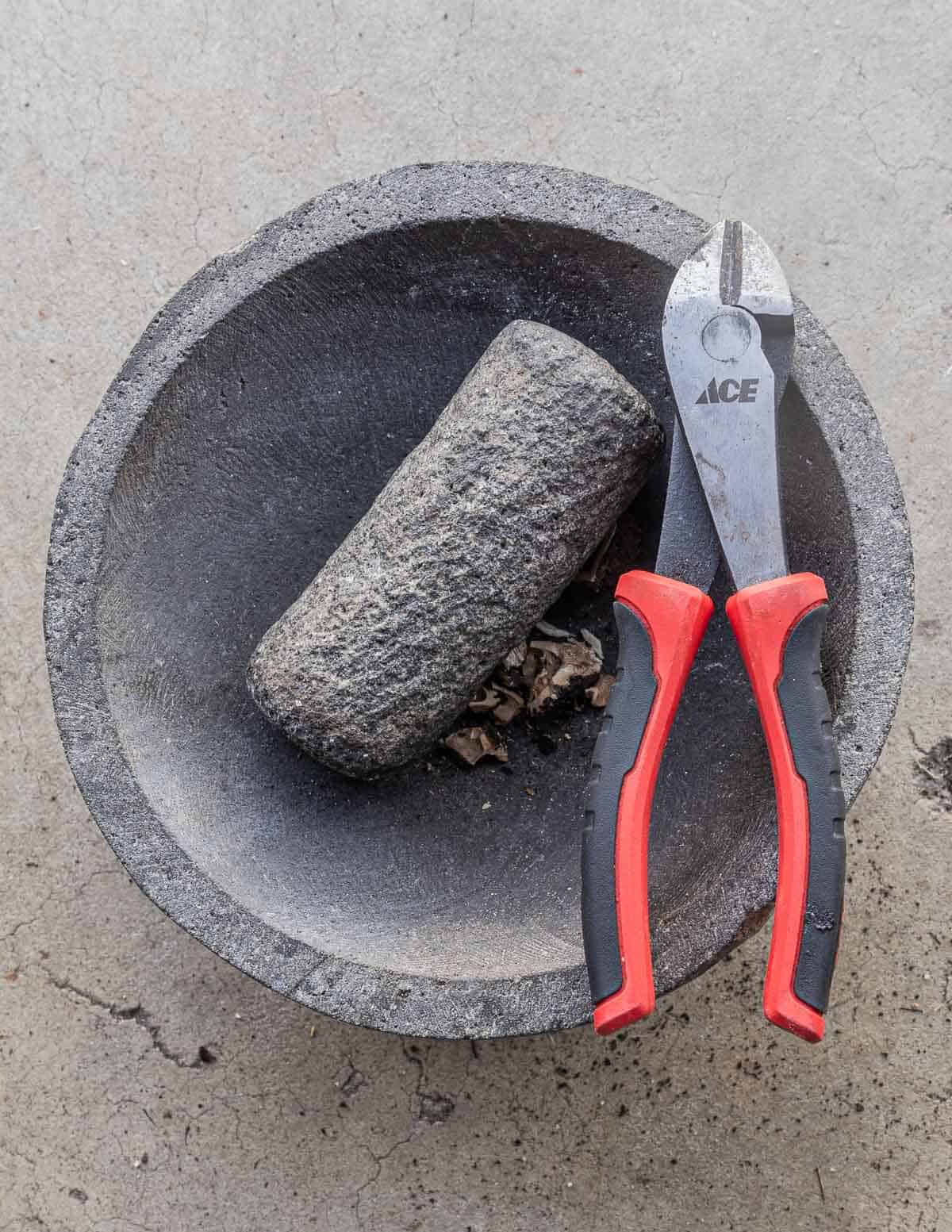
Since they're made from basalt/volcanic rock, they're heavy and hard, and no amount of nut cracking or missed hammer blows will harm them. You can also use a vice.
The secret to getting whole ¼'s: a metal snips
Snips are indispensable and without them, even with a great hammer technique, you will never get the picture perfect nuts you see in my images. The snips are used to spot-treat problem shell parts, releasing the perfect quarters. See my video for a hands-on demo.
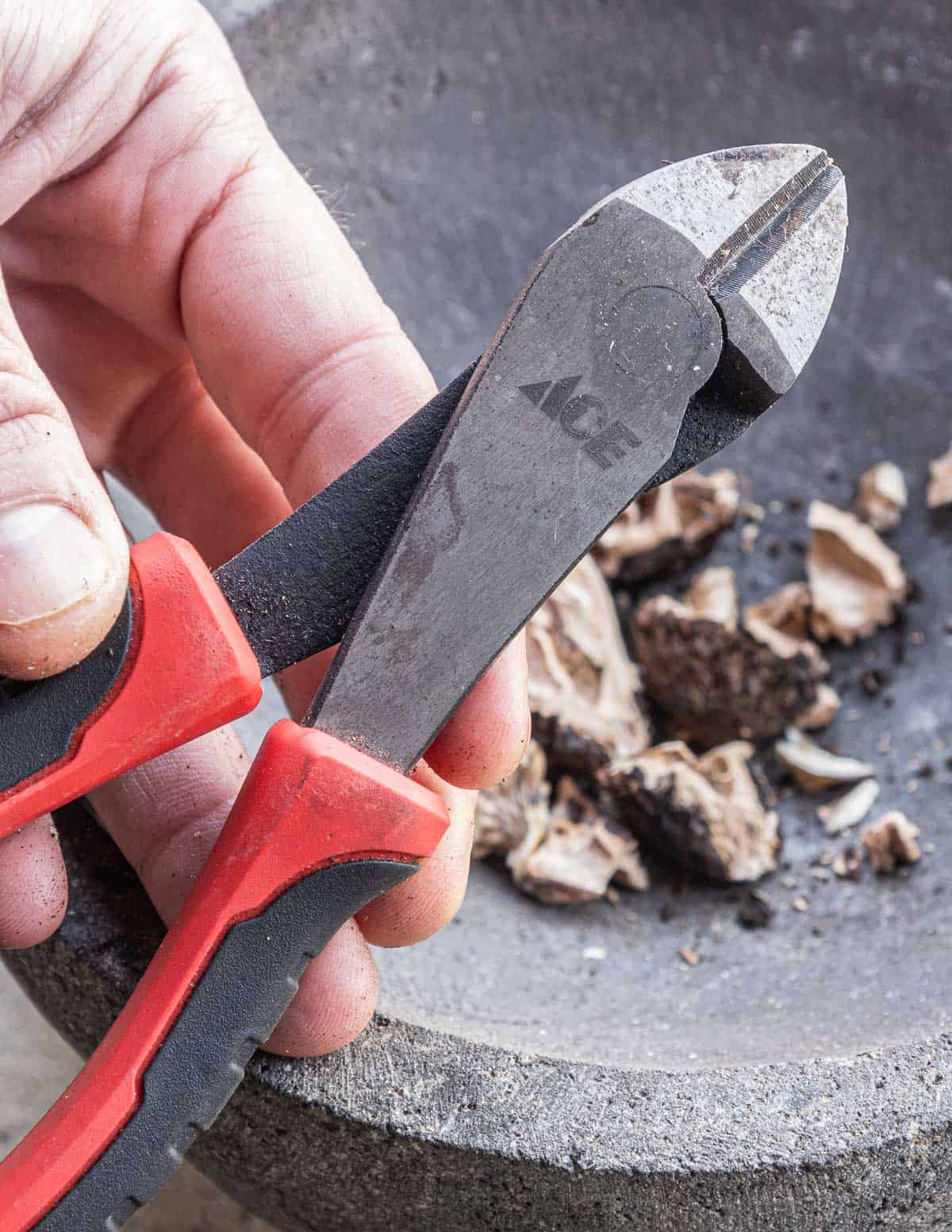
Nut pick, preferably homemade
Conventional nut picks are obtuse, useless tools for black walnuts and other nuts like butternuts and shagbark hickory. They're just too thick, and all they're going to do is crush your precious nutmeats.
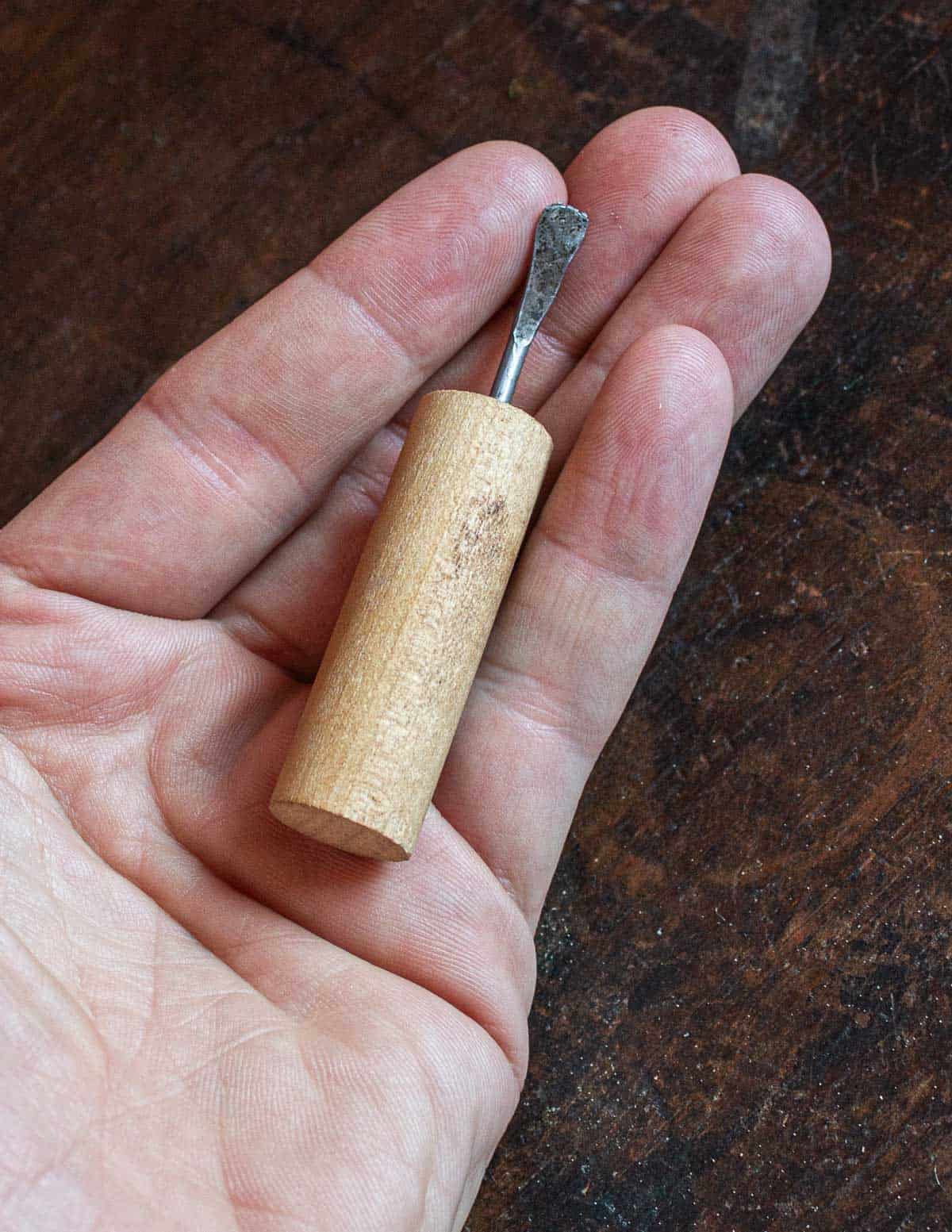
The good part is, it's easy to make a homemade nutpick. Take a dowel, preferably made from birch so it won't split, and cut it into lengths a couple inches long. Pound a nail about halfway into the dowel. Next, pound the head of the nail flat using a hammer--this will be your "pick". Sam Thayer showed me his process of making these, and they're light years beyond conventional nutpicks.
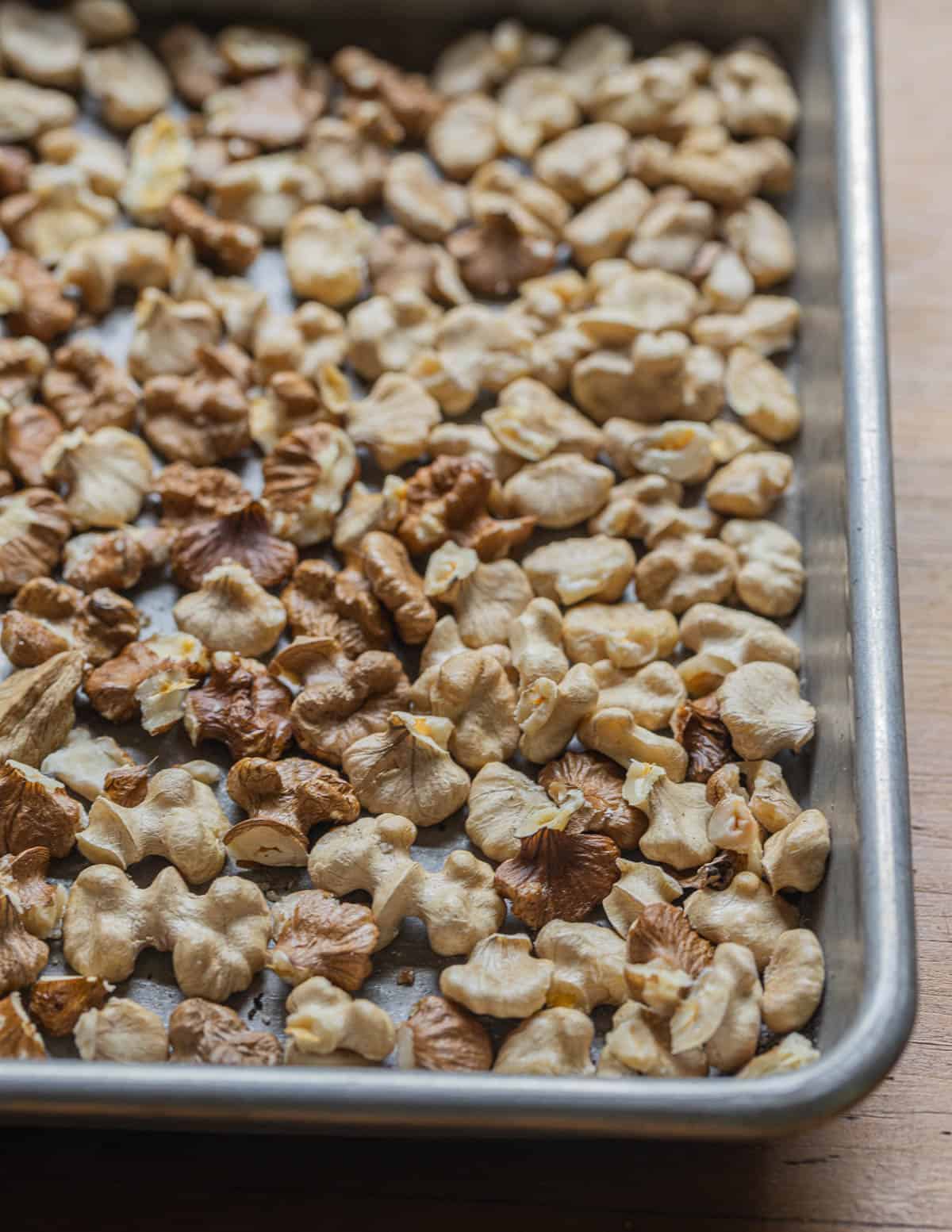
How to crack by hand
Take each nut, and, holding them by the points or seams, give a good crack to the flat portion of the nut just until you hear it crack--don't smash them. Now rotate the nut and give them another crack on the seam (top or bottom).
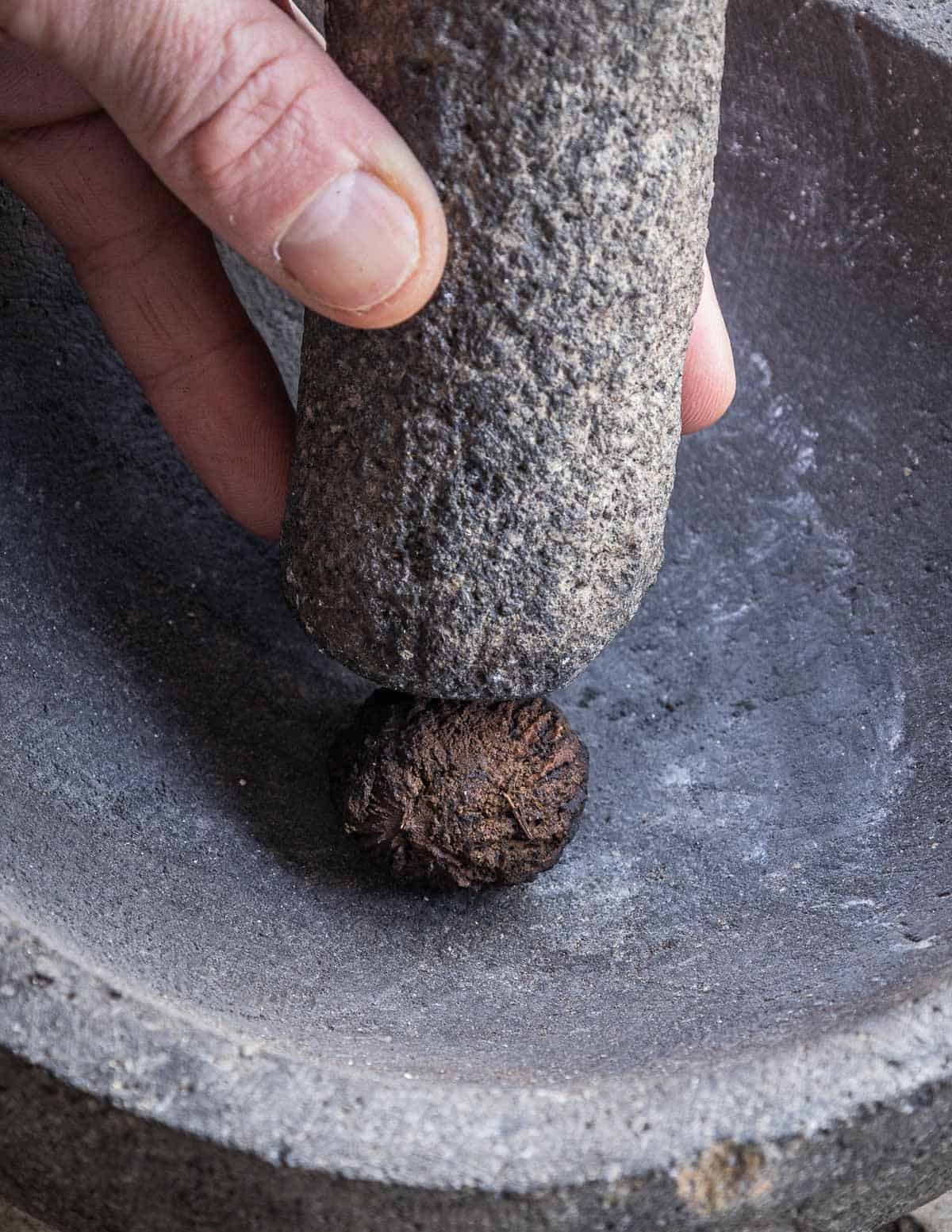
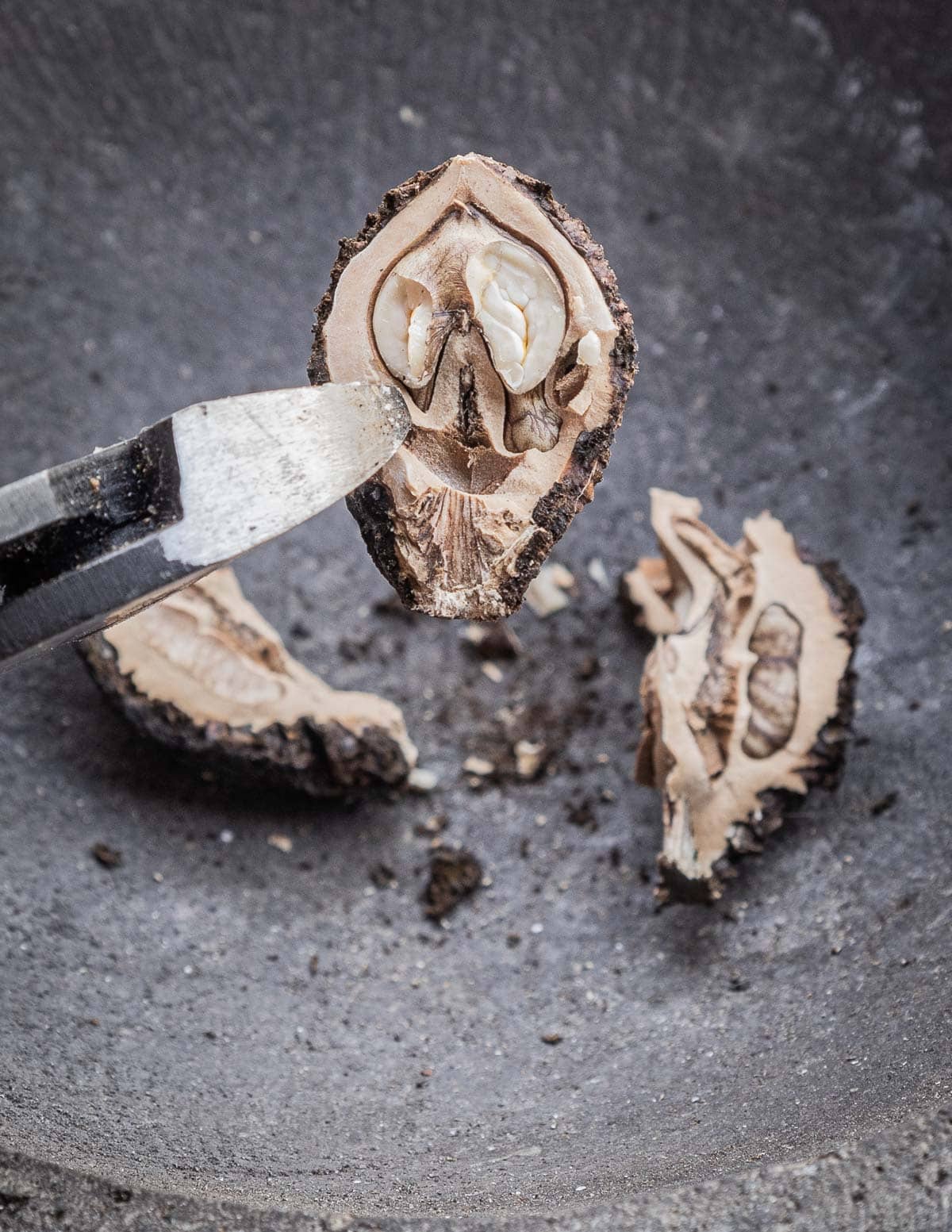
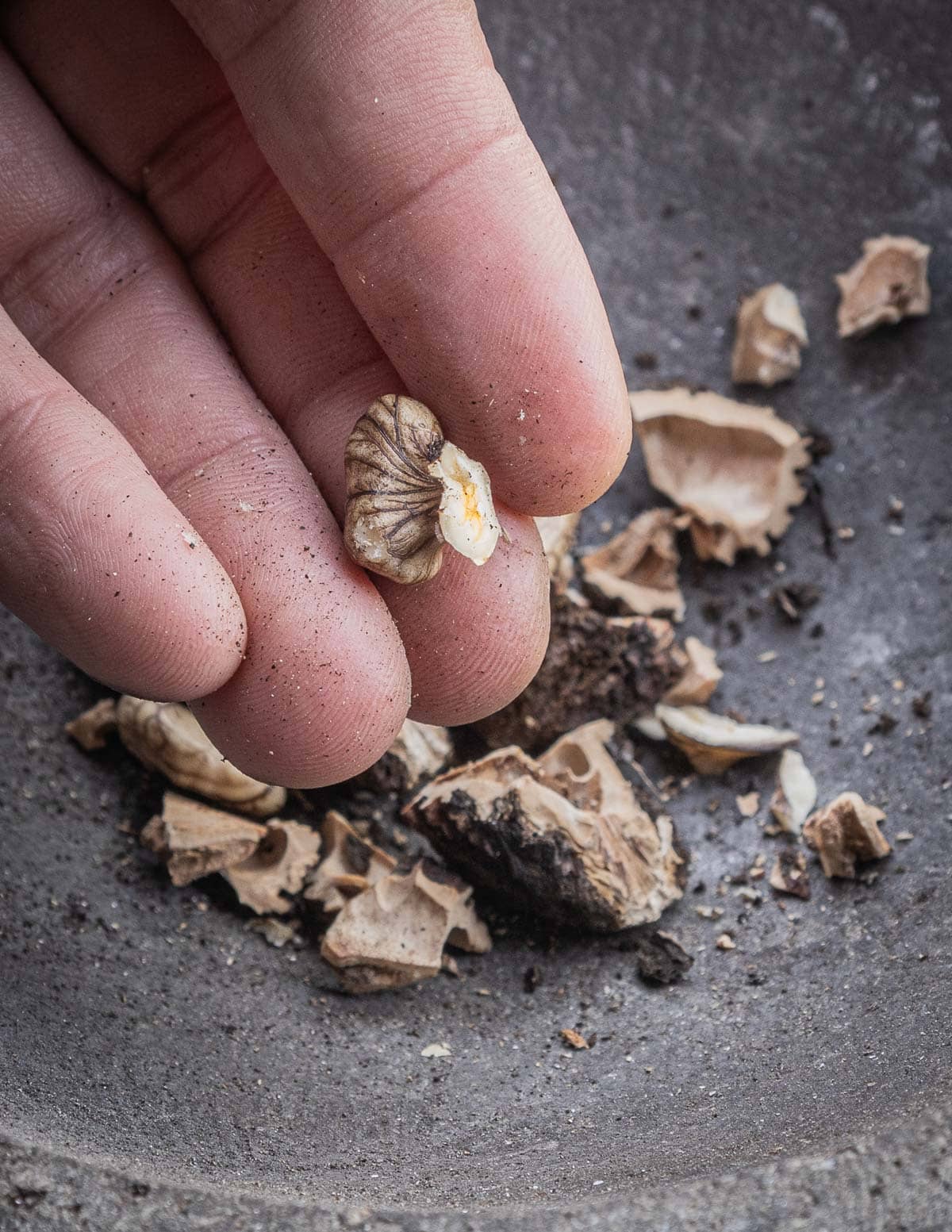
With enough practice you should now have a cracked nut, with 4 whole quarters. Put the nuts in a bowl and continue until you have a large bowl of cracked nuts, then go though each of them, using the snips as needed to free the whole quarters.
After cracking, rinse and dry the nuts to remove any tiny shell particles that can crack teeth.
The best black walnut cracker/sheller
There's a few products on the market that make things easier, but one of them stands above the rest. The Grandpa's Goody Getter is by far the easiest, most efficient black walnut cracker I've ever used. It's an investment, but it's worth it.
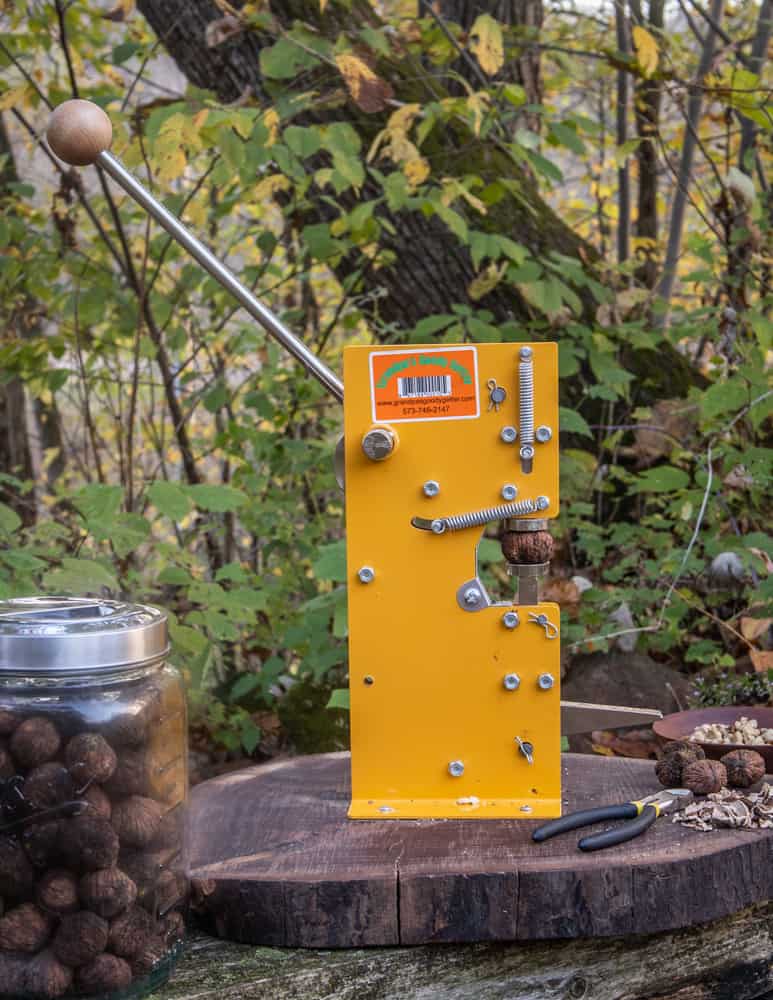
Cooking
To me, black walnuts are really the Rolls Royce of nuts, and there's nothing like a freshly cracked black walnut with it's unique scent and curious aroma. The flavor is incredibly strong, and keeps throughout cooking in whatever you make, bread and baked goods like cookies and cakes, or just sprinkled over granola or yogurt.
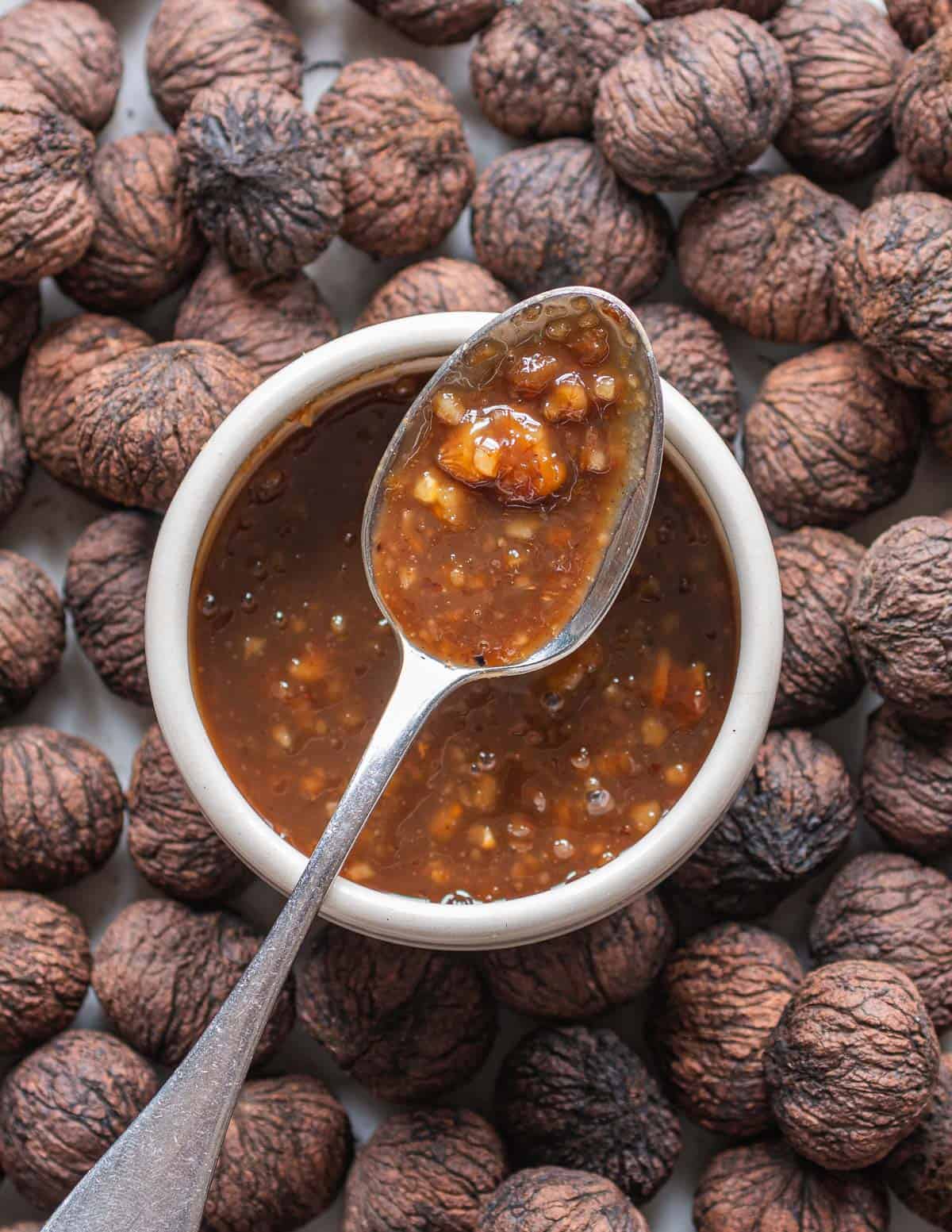
Since you just went through a lot of work to get all those perfect halves, I think it's good to leave them in large pieces, generally. One of the purest ways to enjoy black walnuts is to simply sprinkle them on things. Ice cream is pretty epic too.
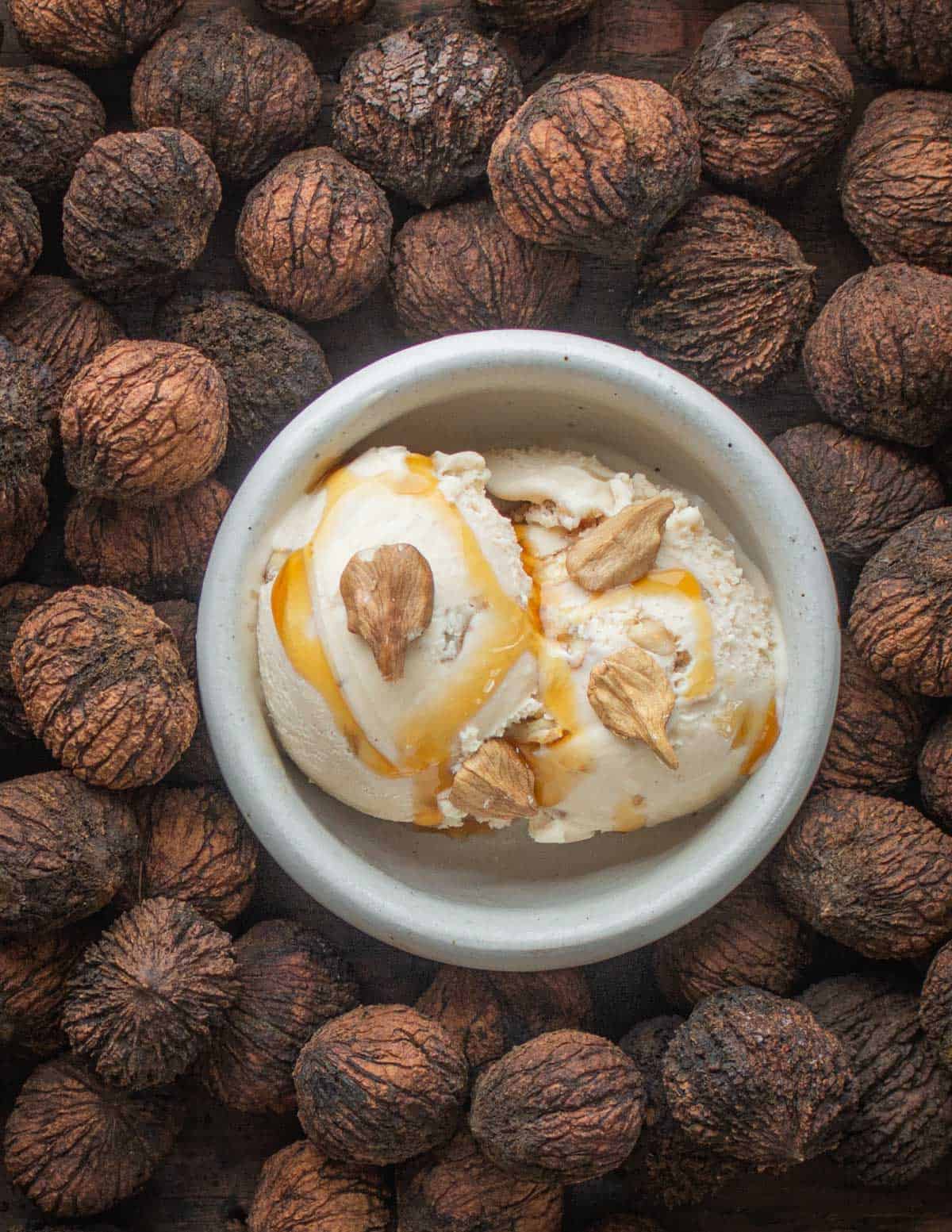
More Recipes with Black Walnuts
Additional Information
Do fresh nuts need to be toasted?
Once the nuts are shelled, the perfume and aroma is at its peak and there's no need to toast the nuts, contrary to what I drilled into my line cooks for years.
But, as nuts sit in on a shelf the flavor diminishes and, after a month or two, a gentle toasting will revive them a bit. I always toast nuts that've been stored or frozen.
Rancid nuts
Black walnuts are widely known for their tendency to go rancid stored at room temperature. How do you know if the nuts are rancid? If you eat it and it tastes terrible, like mold, it's rancid.
Always store black walnuts in the fridge after cracking. For long-term storage, vacuum seal them and freeze.
Yellow streaking
Once I started cracking black walnuts from trees in Wisconsin, I noticed that some had yellow streaks. Terrified of the nuts being rancid, I threw plenty of them out. That was a mistake. Referring back to rancid nuts, if your black walnuts are rancid, you will definitely know.
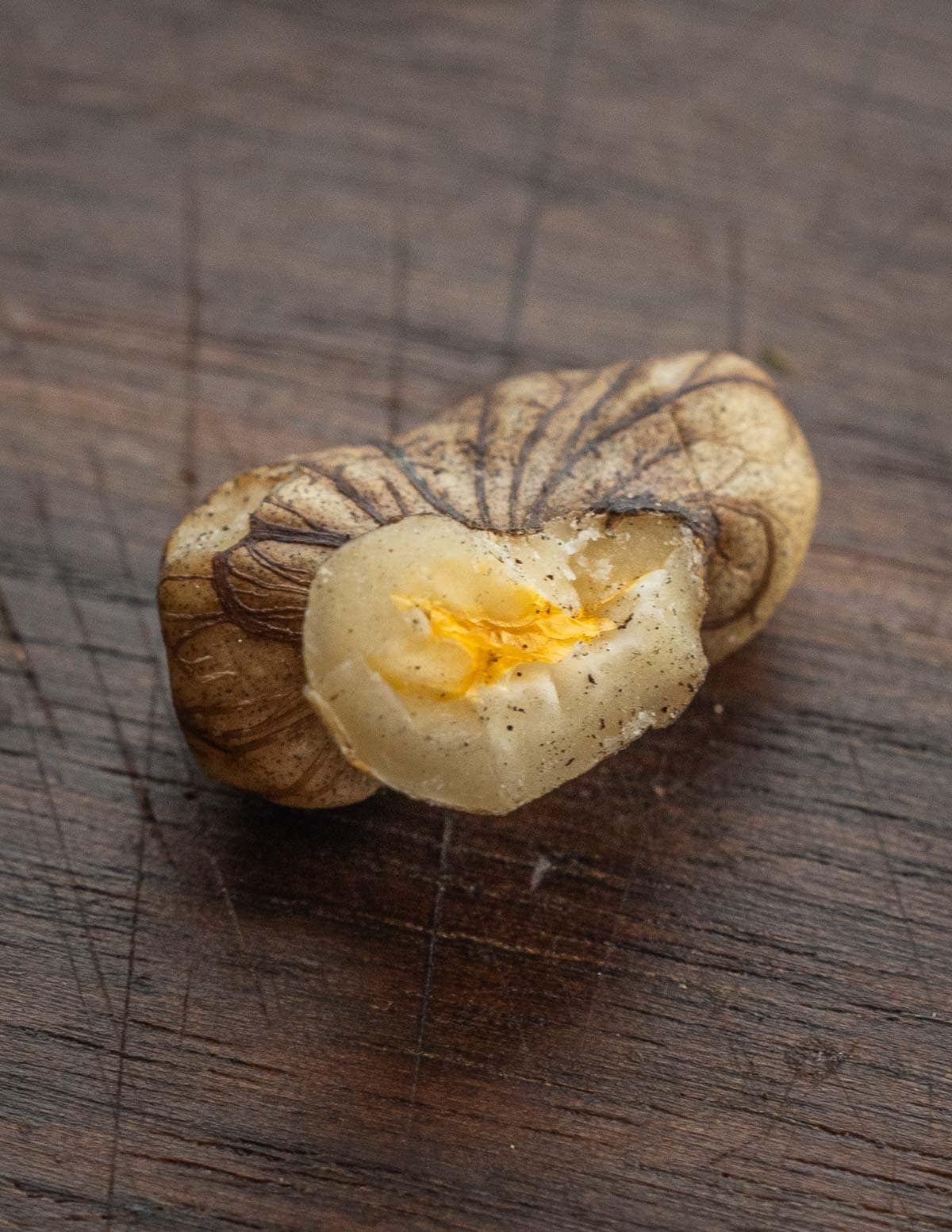
As far as I can tell, the yellow streaking is a harmless anomaly (Sam Thayer said it might be related to temperature) but, if you know the science behind yellow streaking in black walnuts, let me know. Rest assured, I've eaten plenty of nuts with yellow streaks, and they're just as delicious as other black walnuts.
Uses for cracked nut shells and scrap
After you've cracked some black walnuts, you'll have plenty of shelled nuts, and probably a few with small pieces of nut meat left inside. I save all my nut cracking scrap in a box in the garage, then I make piles of the spent nuts on a rock in the backyard.
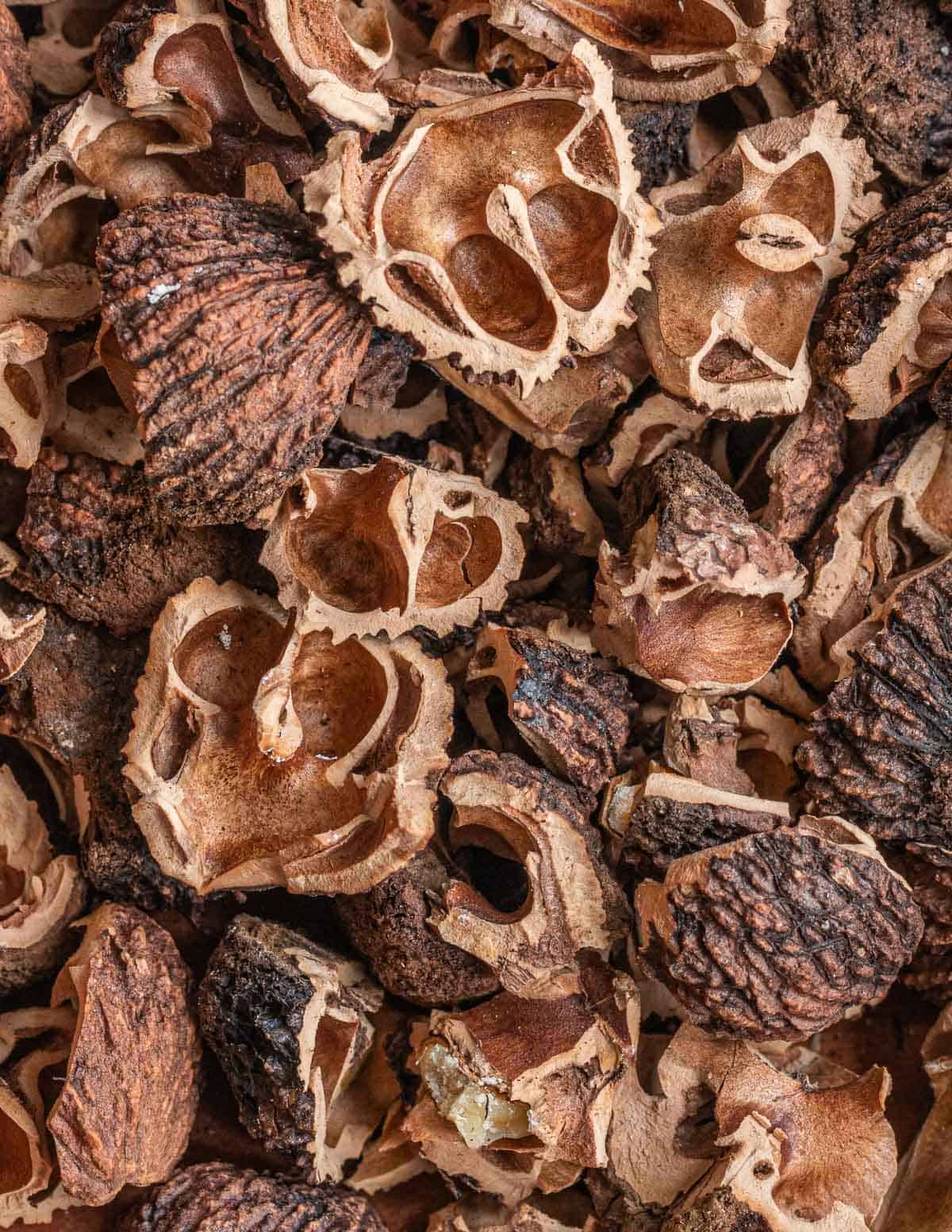
Every morning I get to witness the birds and squirrels who come to feast on the nuts left in the shells—it's a great way to share your harvest!
Squirrel bait
We know squirrels love to steal black walnuts. If you like to eat squirrel occasionally as I do, know that spent black walnut hulls and shells make some of the best squirrel bait you can find. Put some spent nut shells in a trap and watch them come.
Green, unripe walnuts
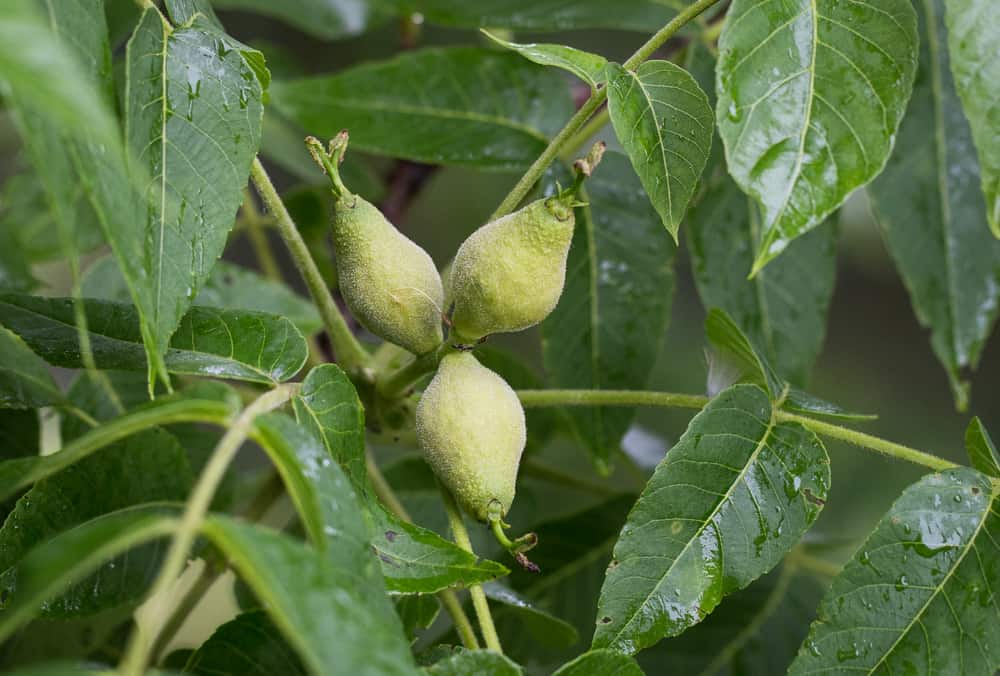
Black walnuts, and other walnuts, give us a lot more than just nuts and oil. The green, meristematic nuts have long been used for making edible products and things from condiments to preserves and liquors.
Green walnuts are outside the scope of this post, but I do harvest plenty of them, typically in June in Minnesota and Wisconsin. You want them about the size of a ping-pong ball, or sometimes smaller, depending on the recipe you're preparing.
If a knife or pin can't be stuck through the young black walnut, it's too old, but can still be used to make nocino. Unripe black walnut leaves are also harvested to make different things, most notably black walnut bay sauce, a sort of vinegar infusion.
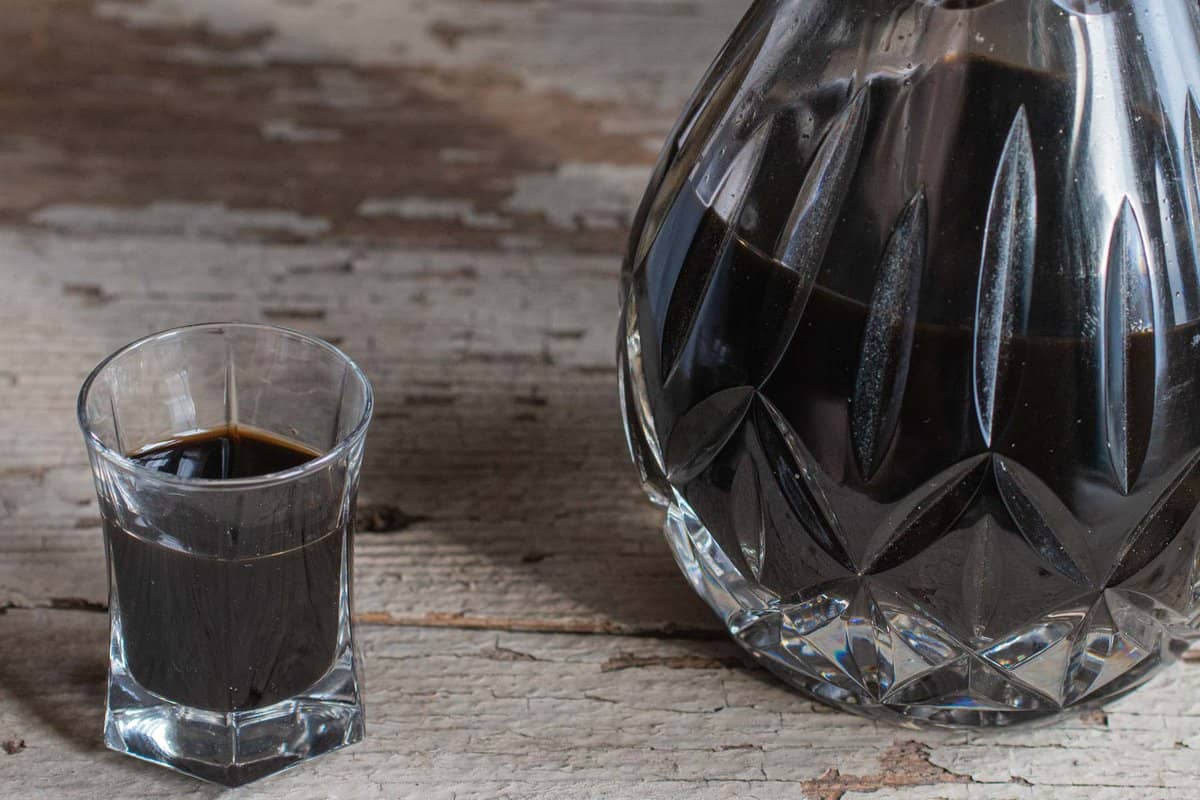
Butternuts: the white walnut or juglans cinerea
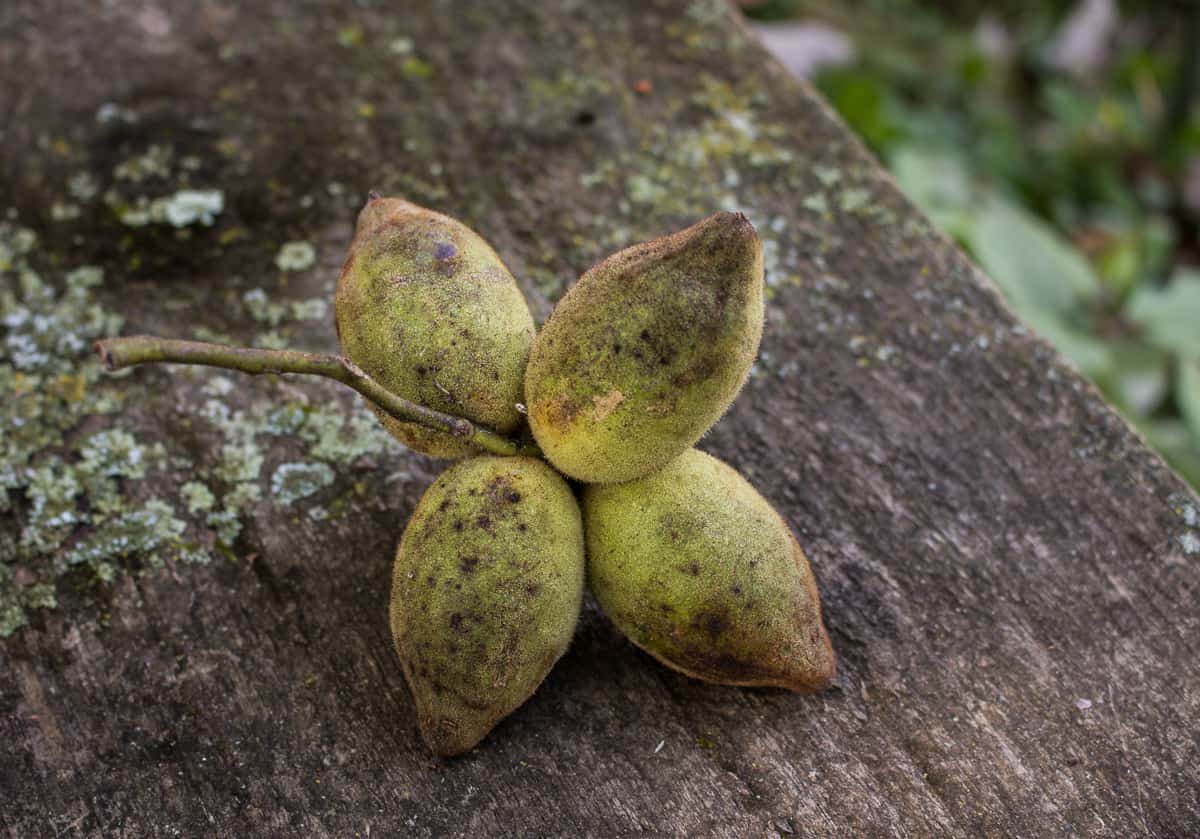
Butternuts are similar to black walnuts, but also very different, so different that I'll write about them in a separate post. For our purposes here, know that if you find some butternut trees, you're lucky, since they suffer from butternut canker, and they're numbers are dwindling.
In Minnesota, they're listed as an endangered species. The flavor of the nuts is nothing like black walnuts. Butternuts are fresh, buttery, and without any sort of tannins like English walnuts. They're delicious, but more difficult to find than black walnuts.
How to Harvest and Store Black Walnuts
Equipment
- Large plastic tub
- Boots
- Gloves
- Gunny sack or boxes for storing/drying
Ingredients
- Waterproof gloves
- 5 gallon bucket or another container
- Drying racks or milk crates
Instructions
Harvest the nuts
- Harvest the nuts in late fall, using the heel of your boot to remove the green hull. Pick the nuts up with gloves as they stain.
- For large batches, you can put the nuts in a 5 gallon bucket, cover them with water and stir with a paint or mortar mixer drill attachment to remove the hulls.
Washing
- Wash the nuts until the water runs clear
Drying
- When the nuts are clean, lay them out to dry, without putting them in a large pile, in a ventilated area. They'll dry up to twice as fast with a fan blowing on them. A garage works great.
Storing
- Once the nuts are dried, they can be stored for years for use as a food. You can test a walnut to see if it's done by cracking some, the nut meats should be loose in the shell. Freezing black walnuts after cracking.

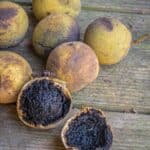
Hinda Rubinstein
Hi,
I dried my black walnuts incorrectly. I got most of the hulls off but didn't wash them until the water ran clear. I dried them and just cracked them and lightly roasted them. Then I put the black walnuts on banana bread and cooked it all. They taste really astringent. I'm guessing thats from the hull soaking into the nut? Are they dangerous to eat like this or just not tasty?
Alan Bergo
Hi Linda, I experienced this personally so I can't tell you for sure, but thanks for explaining in nice detail. The questions I would have are-have you ever had black walnuts before? If you haven't, try ordering a small bag from Hammonds so you know what's coming-that will take out a lot of guesswork here. Either way if they're just black walnuts dried as you describe they're not harmful.
Stuart
Hi Alan. Are your Ace hardware diagonal cutters holding up? Mine broke yesterday after maybe 400 pounds of walnuts. I'm researching diagonal cutters with better leverage. The 6 inch cutters are tough on my hands
Alan Bergo
Hey Stuart, mine are holding up, but I started working with Hammons Black Walnuts this year so the amount I crack personally is negligeable now. The good part is by collaborating with them I was able to serve over 100 lbs of cracked BW in 2024. I would just experiment with whatever feels good in your hand. Sorry yours broke, 400 lbs is a lot of nuts. Let me know if you find a model you really like and I'll add a link here.
Todd
I saw a group of trees the other day with literally 1,000’s of nuts on the ground. The only problem was I was too late and the hulls were already decomposed and it was just the bare nuts on the ground.
If the shells appear to be intact and they pass the float test, do you have thoughts on gathering nuts on the ground that have reached this stage?
Thanks as always for your opinions and sharing your thoughts!
Alan Bergo
Hey Todd! I actually just picked a bunch like that for a show since there hasn’t been rain here and it was basically all I could scrounge up. Bring a hammer or grab a rock and crack a few in the field before you pick them to make sure they look ok inside. They’ll probably be fine.
Todd Holmberg
Alan- thanks for the info! I was wondering if you could give your thoughts on “hull consistency”, and where you draw the line.
I am seeing a lot of hulls that are totally dark (no green color remaining), partially decomposed/worn off, and are fairly hard (unable to dent with finger pressure). Are these ok to use? I am nervous about tainting the batch if I mix them in with the others.
Any thoughts you might have are appreciated- excited to try some recipes off your site.
Thanks!
Alan Bergo
Hi Todd. Those nuts are perfectly fine. I call them late season nuts. I actually just filmed harvesting a bunch of black ones for Minnesota Bound this past week. I should mention some (like Hammons black walnuts) instruct people to harvest them as soon as possible. I haven't encountered a noticeable bitterness or anything with older nuts I've harvested though.
Josh - MatterofSnack
First time out gathering black walnuts although I have very fond memories of my brother and I zinging these at each other when we were much much younger.
Modest haul for me as a first timer. I can't wait to try some of your recipes out and find my favorite ways to use these! I always appreciate your willingness to share your info and everything you've learned over the years.
Quick question about drying and curing... is 2-3 weeks a safe assumption in general? How will I know they've dried completely and cured and are safe for long term storage? Either way, thanks again, and super excited to be on the black walnut bandwagon!
Alan Bergo
Hi Josh. You’ll know when the nuts are ready as the shells will be bone dry. Just crack some and you’ll see.
John Wenzel
What happend to the Black walnuts this year ?? There are none here in Virginia.
Alan Bergo
Black walnuts can mast ever other year, some trees can mast every year. Seasonal fluctuations and acts of nature can also affect them. For example, if something disrupts them in the spring it could ruin the crop. FWIW, I was just in MO touring the black walnut operation at Hammons last week. Great year for them there.
Drew from the Driftless
Thank you, Alan, for all of this great information on Black Walnuts. This was my first year harvesting and eating them and I think they're delicious! I cracked a few with a hammer before following your recommendation and getting the Grandpa's Goody Getter. It is indeed a great machine and I look forward to using it for many years.
Do you recommend to crack and freeze the nuts when they're at the right cured/dried stage? I have tried cracking and eating them at several stages from immediately after removing the husks where the meat is all white and I liked that but the flavor stuck around for a bit too long afterward. However, If I cure them for very long then the meat becomes a little chewy and stale textured.
Alan Bergo
Hello Drew. The way you cure and crack black walnuts is to remove the hull, wash and clean, then lay them to dry for a few weeks. When the shells are brittle enough to crack they're ready. They can be stored in a garage for a few years. I do not crack and freeze nut meats, but it's important to remember that once they're cracked and out of the shell the nuts will eventually go rancid.
Angelica H
Hi, love all your research and guidance on foraging, thanks for all you put in!! Question, if I collect the black walnuts, shuck them, and wash them, is it weird to immediately shell them? I cracked one right after processing it, within 24 hours of collecting. All the recipes I see say you have to cure the nuts, but when I cracked this one it was so easy to extract the nut and the meat tasted really good. What do you think? If this gets a go ahead from you, I would crack them without curing and freeze the nut meat just because I know they weren't cured.
Alan Bergo
Hello. As a general rule, nuts are dried to improve their shelf life and lock in a good flavor that can be compromised from moisture. Drying makes them easier to crack, but if you prefer to crack them while they're still damp and freeze them right away I see nothing wrong with that.